ON THE PALAU SIREN!


Search form
- Best Scuba Diving In The World
- Best Diving in Asia
- Best Diving in Africa
- South Africa
- Zanzibar, Tanzania & Kenya
- African Land Safaris
- Tanzania Land Safari
- Australia Best Diving
- Great Barrier Reef
- Caribbean Best Diving
- British Virgin Islands
- Cayman Islands
- Dominican Republic
- Jardines de la Reina
- Roatan, Utila & Guanaja
- Saba, St Kitts & St Eustatius
- St. Vincent and the Grenadines
- Tiger Beach
- Trinidad & Tobago
- Turks and Caicos
- Best Diving in Costa Rica
- Cocos Island
- French Polynesia Best Diving
- Galapagos Islands
- Andaman Islands
- Indonesia - Top 10 Areas
- Cenderawasih Bay
- Derawan Islands
- Lembeh Strait
- Manado and Bunaken
- Raja Ampat Area
- Wakatobi National Park
- Best Scuba Diving in Mexico - Top 9
- Baja California
- Cabo San Lucas
- Guadalupe Island
- Isla Mujeres
- San Ignacio Gray Whales
- Sea of Cortez
- Socorro Islands
- Micronesia Dive Guide
- Bikini Atoll
- Truk Lagoon
- Saudi Arabia
- Southeast Asia - Top Areas
- Philippines - Top Areas
- Cebu and Bohol
- Malapascua Island
- Puerto Galera
- Papua New Guinea
- Solomon Islands
- Thailand Best Diving
- Similan Islands
- Best Diving in the USA
- Best Scuba Diving in Hawaii
- Catalina Island
- Southern California
- All 110 Destinations
- Best Liveaboard Destinations
- All Liveaboard Destinations
- Bahamas Liveaboards
- Belize Liveaboards
- Caribbean Liveaboards
- Cocos Island Liveaboards
- Galapagos Liveaboards
- Great Barrier Reef Liveaboards
- Indonesia Liveaboards
- Komodo Liveaboards
- Maldives Liveaboards
- Norway Liveaboards
- Palau Liveaboards
- Philippines Liveaboards
- Raja Ampat Liveaboards
- Red Sea Liveaboards
- Sea of Cortez Liveaboards
- Similan Island Liveaboards
- Socorro Liveaboards
- Tubbataha Liveaboards
- Turks & Caicos Liveaboards
- 170+ Liveaboards Worldwide
- Bali Dive Resorts
- Belize Dive Resorts
- Bonaire Dive Resorts
- Caribbean Dive Resorts
- Cayman Islands Dive Resorts
- Cozumel Dive Resorts
- Fiji Dive Resorts
- French Polynesia Dive Resorts
- Indonesia Dive Resorts
- Maldives Dive Resorts
- Mexico Dive Resorts
- Palau Dive Resorts
- Philippines Dive Resorts
- Raja Ampat Dive Resorts
- Roatan, Utila, & Guanaja Dive Resorts
- Sipadan Dive Resorts
- 200+ Dive Resorts Worldwide
- All Guided Group Trips
- swim with whales
- Off the beaten track
- African Safari Trips
- Bluewater Travel's 50 Amazing Adventures
- Secret Sale
- All Dive Travel Specials
- Best Of Articles
- All Articles
- Top 10 Lists
- Top Luxury Liveaboards
- Top Rated Liveaboards
- Travel Search
- Travel Insurance
- Terms of Service
- Leave a review
- Learn Underwater Photography
- Buy Underwater Camera Gear
- Get Scuba Certified
Cocos Island Diving
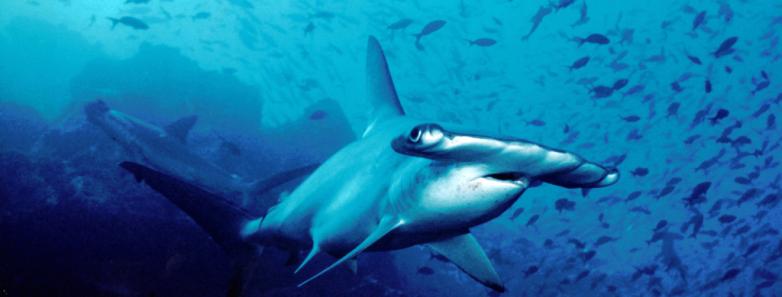
Scuba diving in cocos island, Costa Rica
Cocos island diving highlights.
Cocos Island is one of the world's best scuba diving destinations for diving with big animals . Schooling hammerhead sharks is what the Cocos Island diving scene is most famous for, but you can find many other shark and ray species, including white tip reef sharks, silky sharks, the occasional whale sharks, manta rays and marble rays.
Cocos is also home to 27 endemic fish species including the red-lipped batfish , that are also commonly found in the Galapagos. Divers can also see large schools of jacks and tuna, Creole fish, green turtles, and octopus, and the list goes on...
Interested in Cocos Island? View the live availability of some of the best liveaboards in Cocos Island and book online at the best price or check out our sidebar for specials and workshops there!
Read why Cocos is one of the best shark diving destinations in the world.
Marine Life & Environment - Diving Conditions
How to Get There - How to Dive Cocos Island - Best Time to Dive
NEW! Find a Liveaboard - Practical Information - Book a Trip
Intro to Cocos Island
Belongong to Costa Rica, Cocos Island is the mecca for divers looking for big animals, open ocean, and advanced diving. Howard Hall's film " Island of the Sharks " was filmed here, and sharks are the main attraction. Cocos Island is not a place with pretty corals or reefs. It is a gorgeous, uninhabited island, approximately 5 x 2 miles (8 x 3 km) in size. The bottom is a sloping rocky substrate without a lot of colors.
Find out about other places to scuba dive in Costa Rica .
What you do get with Cocos Island diving is amazing marine life - prolific shark populations including reef whitetip and scalloped hammerheads, plus a chance of many other species. There is also great schooling fish action, and a good chance of seeing true pelagics like wahoo, tuna, and even billfish. If you are comfortable with deep (100ft) nitrox diving in open oceans, and the possibility of swell, strong currents and low vis, Cocos Island can be the apex dive trip of your dive career. It is not a place for non-divers.
Interested in pretty coral reefs? Scuba diving in the Philippines is a great option.
Cocos Island is quite a beautiful island to look at topside, and short excursions to the island are possible, but you are on the boat almost all of the time. The island is lush and green with rainforest and waterfalls. Malpelo Island is another destination that Cocos liveaboards sometimes visit during the same trip. It is not that attractive and you can not go ashore.
View Location on Google Map
Back to Menu
Diving Information

cocos island diving with Hammerhead sharks
Hammerhead sharks are drawn to Cocos Island to be cleaned by King angelfish, butterflyfish and other small fish. These islands are basically giant cleaning stations.
Other marine life in cocos island
Scuba diving in Cocos Island is always exciting, with dozens of white-tip sharks usually seen on every dive, at any depth, cruising around the rocks. Enormous schools of big-eyed jacks, barracuda, snappers and grunts are seen on many dives, and the size of these schools must be seen in person to appreciate.
Marble rays are very frequently seen in groups of 5-20, feeding on the bottom at 100ft. Marble rays are easy to approach and are always cruising around like they are on parade.
Whale sharks occasionally pass through, and there are often a couple of sightings on a trip. Large tuna, mantas, silky and silvertip sharks are often seen as are eagle rays. Orcas, tiger sharks, dolphins, wahoo, and sailfish are also seen but not on every trip.
Dolphins and tiger sharks are quite frequently seen, up close. Divers have seen dolphins hunting jacks. Galapagos sharks, which can be aggressive, are not as common but do sometimes appear.
cocos island Diving Conditions
- Water Temperatures: In June/July, the water is sometimes 81 degrees at all depths. It stays from 80-82 during the summer. The water can get much colder, down in the lower 70s in the winter. Thermoclines are common, and deep down can get into the 60s.
- Visibility: In June, July the visibility was 50-70ft. Visibility can be variable but 30-50ft is the norm, with even better visibility from Jan - May.
- Depth Range: 30 – 131 feet (10 – 40m)
Typical Cocos Island scuba Dive
On a typical scuba dive at Cocos Island, you drop down as a group to a depth of 100ft, spread out and find a rock to hide behind. You then look for a cleaning station for hammerhead sharks, which is often a larger rock with many angelfish and butterflyfish around it. Hammerhead sharks are easily spooked by erratic divers' flailing limbs and exhaust bubbles. Attempting to approach these sharks usually only leads to their quick retreat. In order to get a chance at a close approach, enabling opportunities for good photographs, quickly and carefully locating a suitable rock to hide behind and controlling your buoyancy and breathing is essential.
Divers are advised to become "blue" divers; (holding your breath when the sharks approach). By following the divemaster's directions, calming down, being patient you will greatly improve your chances of close passes and prolonged encounters.
3 dives a day are the norm at Cocos Island, with occasional night dives. On several days a night dive will be offered with white-tipped reef sharks. Divers' lights illuminating the fish causes a feeding frenzy with the sharks. Any fish or turtle illuminated by a dive light will be quickly assassinated by several sharks, and because of this, some divers may not enjoy this dive or choose not to do it. On a remote trip like this, you need to pay attention to your depth & time, and follow the divemaster's instructions carefully, and double check your surface marker buoy at the beginning of each dive.
Travel Information
How to get to cocos island.
Liveaboards depart from Puntarenas, Costa Rica, a two hour bus transfer from San Jose, Costa Rica. Travel time is approximately 40 hours to Cocos Island, 43 hours to Malpelo, and 40 hours from Cocos to Malpelo. At certain times of the year the crossing can be very rough with big swells and seasick passengers.
How to scuba Dive Cocos Island
The only way to get to the island is via liveaboard dive boats. Most liveaboards offer 10-day trips, with 7 days of diving and 3 dives a day.
Best Time to scuba Dive Cocos Island
Scuba diving Cocos Island can be done in both rainy season and dry season. If you visit the islands in June/July, you may have a chance of having both big animal encounters and calm seas. The dry season is Dec - May, which can bring silky sharks, dolphins and mobulas, calmer waters and smoother crossings. The rainy season is June - Nov; and crossings can be a little rough, there's a lot of rain, but Hammerhead sharks are in larger numbers. That said, you will usually see good numbers of hammerheads throughout the year. May - Aug are probably the best months to go, but sightings/conditions can be highly variable. Note that hammerhead sharks sometimes go deep during an "El Nino" year.
Topside & Non-Diving Activities
Costa Rica is one of the top nature destinations in the world. There are excellent opportunities to see monkeys, toucans, brilliantly colored tree frogs, parrots, sloths, and many more birds and animals. The country is small, easy to travel around, and relatively safe. Make sure you know what to pack for Costa Rica so you've got everything you need to enjoy every minute of your trip without having to worry where to find it when you're there! We highly recommend some time exploring the county either before or after your Cocos trip. There are not many non-diving activities at Cocos Island itself.
Liveaboard availability
Back to Menu
Other Useful Information
Practical information.
- Currency: Costa Rican Colón (CRC)
- Language: The official language is Spanish, but English is widely spoken within tourism-related areas
- Main Airport Code: SJO
- Time Zone: UTC-6
- Electricity: 120V / 60Hertz
GOT QUESTIONS? READY TO BOOK?
Call us today at 310-915-6677 or email us [email protected]
And let us book your dream vacation!
Reviews (3)
- Sort Recent
- Sort Helpful
- Sort Alphabetically
- Top Reviewer
Cocos is scalloped hammerhead central. If you want to get close to hammerheads daily, and see a wall of hammerhead sharks, there are not many places that can compare than Cocos. Expect to also see massive schools of Jacks, lots of marbled rays, Galapagos sharks, silvertip sharks, silky sharks and white tip reef sharks. Making an occasional appearance are also tiger sharks, whale sharks and mantas. leave your macro lens at home. The best night dive in the world can also be found in Cocos where you see hundreds of whitetips hunting for food and getting into a feeding frenzy. There is no need for baited shark dives. The island itself is a beauty. You will pass by numerous waterfalls on your way to the dive sites. A visit to to the ranger station and a hike up to a viewpoint is also a must do on Cocos Island. A dive trip to Cocos is an adventure of a lifetime and well worth the 36 hour crossing from Puntarenas on mainland Costa Rica.

Cocos Island is my favorite dive destination - I have only had other trips come in second or third but never ahead of this one! We dove with the Undersea Hunter group and they are excellent on all levels. They have three boats for their live aboard operations; The Sea Hunter, Undersea Hunter and the Argo. We stayed on the Undersea Hunter which is the smallest boat and therefore takes a smaller group of people which I prefer. The Argo is the more luxurious vessel and is a very beautiful if you don't mind parting with the extra money. There is also a deep sea submersible that sometimes goes out on the Sea Hunter if there are guests that want the experience of a deeper dive.
Every dive site we went to had something spectacular to see. Besides large schools of hammerheads at sites like Alcyone, we saw silky and galapagos sharks. An added adventure is night diving with schools of white tips on the hunt. There is no end to what you can see at sites like Manuelita (outside) because the currents bring in all sort of pelagic life; several species of rays, whale sharks and tiger sharks. Turtles, sharks and rays continuously circle in the shallows looking for the cleaner fish and it's a treat to watch all the activities. It's amazing what can swim by on an open water drift. We had dolphins, sharks and rays pass us on an early morning safety stop.
Then there are the fish! Not everyday fish either! Cocos is a place where you can see the oddball batfish in relatively shallow water. I found the always busy leather bass fun to watch and photograph. You will also see very large schools of jacks and large predatory fish that the sharks follow in search of food.
The crew on the boat are the best and so is the food. The cabins were comfortable and there were plenty of places to relax on the boat. You will want for nothing on the Undersea Hunter boats!
Dive Specials

Liveaboards

BE THE FIRST TO GET NEWS AND SPECIALS
Sign up for the mailing list today

310-915-6677 [email protected]
- OUR DIVE TRAVEL EXPERTS
- TERMS OF SERVICE
Cocos Island National Park
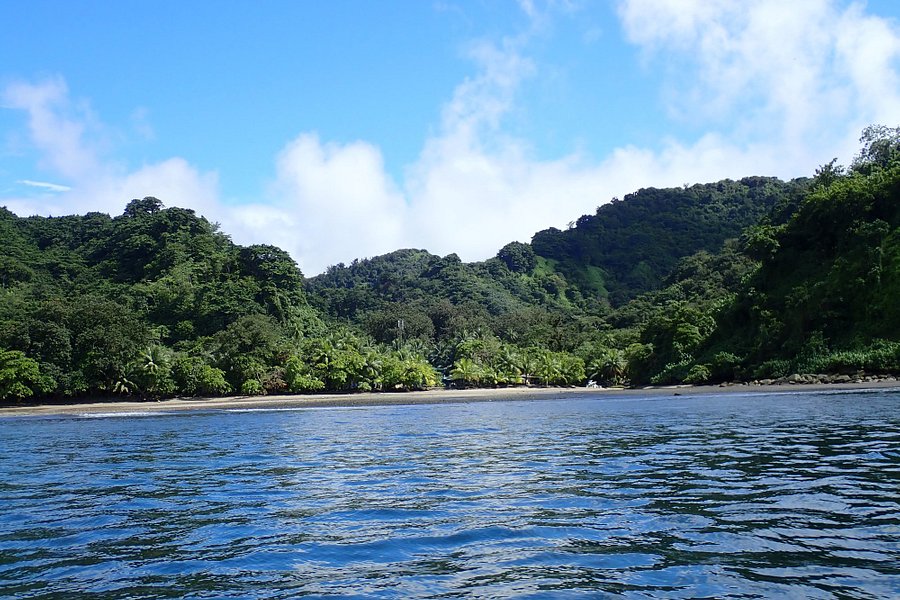
Top ways to experience nearby attractions

Most Recent: Reviews ordered by most recent publish date in descending order.
Detailed Reviews: Reviews ordered by recency and descriptiveness of user-identified themes such as wait time, length of visit, general tips, and location information.
Also popular with travelers
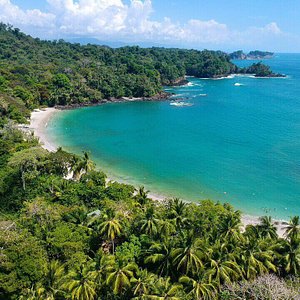
Cocos Island National Park - All You Need to Know BEFORE You Go (2024)

Australia Recommends 2024

Come and Say G'day

G'day, the short film

Discover your Australia

Travel videos

Deals and offers

Australian Capital Territory

New South Wales

Northern Territory

South Australia

Western Australia

External Territories

The Whitsundays

Mornington Peninsula

Port Douglas

Ningaloo Reef

Airlie Beach

Kangaroo Island

Rottnest Island

Hamilton Island

Lord Howe Island

Tiwi Islands

Phillip Island

Bruny Island

Margaret River

Barossa Valley

The Grampians

Hunter Valley

McLaren Vale

Glass House Mountains

Alice Springs

Uluru and Kata Tjuta

The Kimberley

Flinders Ranges

Kakadu National Park

Eyre Peninsula

Karijini National Park

Great Barrier Reef

Blue Mountains

Daintree Rainforest

Great Ocean Road

Purnululu National Park

Cradle Mountain-Lake St Clair National Park

Litchfield National Park

Aboriginal experiences

Arts and culture

Festivals and events

Food and drink

Adventure and sports

Walks and hikes

Road trips and drives

Beaches and islands

Nature and national parks

Eco-friendly travel

Health and wellness

Family travel

Family destinations

Family road trips

Backpacking

Work and holiday

Beginner's guide

Accessible travel

Planning tips

Trip planner

Australian budget guide

Itinerary planner

Find a travel agent

Find accommodation

Find transport

Visitor information centres
Deals and travel packages

Visa and entry requirements FAQ

Customs and biosecurity

Working Holiday Maker visas

Facts about Australia

Experiences that will make you feel like an Aussie

People and culture

Health and safety FAQ

Cities, states & territories

Iconic places and attractions

When is the best time to visit Australia?

Seasonal travel

Events and festivals

School holidays

Public holidays
How to get to Australia's most iconic cities

How long do I need for my trip to Australia?

How to travel around Australia

Guide to driving in Australia

How to hire a car or campervan

How to plan a family road trip

How to plan an outback road trip

Cocos (Keeling) Islands © Cocos Keeling Islands Tourism Association
Guide to Cocos (Keeling) Islands
- Share Share on Facebook Share on Messenger Share on Twitter Share on WhatsApp Copy Link
- Getting to Cocos (Keeling) Islands
- When to visit
Discover Australia’s most remote and idyllic outpost, the Cocos (Keeling) Islands.
The Cocos (Keeling) Islands, or simply “Cocos” to locals, are 27 breathtaking islands in an almost perfect circle – only two of which are inhabited. Snorkel, boat, fish, kite surf or dive in the warm, crystal-clear lagoon which forms one of the largest marine sanctuaries in the world. Discover the unique Cocos Malay culture or simply relax on empty white-sand beaches. With just 600 residents and visitors capped at 144 at any time, these tropical islands offer a world away.
Flights operate from Perth to Cocos (Keeling) Islands two times per week (Tuesday and Friday). The flight duration is under five hours and includes a stop at Christmas Island, perfect for extending your trip. Although a domestic route, the flight to Cocos departs from the T1 International Terminal in Perth, and you'll need photo identification to clear customs.
- Cocos (Keeling) Islands Airport (CCK) is located on West Island
- The airport is a short drive from much of the island’s accommodation
Though West Island is small, consider hiring a car or scooter to explore at your leisure. Bicycles are also available for more active visitors.
For more Cocos (Keeling) Islands travel tips, visit the website .
The Cocos (Keeling) Islands experience a consistent tropical climate year-round. Temperatures rarely drop below 24°C (75°F) even at night, so packing lightweight clothing is a good idea. Rainfall is typically higher between March and July, but this season also brings higher winds perfect for kitesurfing.
- High season: April to November
- Low season: February to March
- Don’t miss: The Hari Raya Puasa (end of Ramadan) celebration on Home Island

14 incredible days on Christmas and Cocos (Keeling) Islands
Destinations near the cocos (keeling) islands.

Christmas Island

The Coral Coast

Travellers' stories

Planning your trip to Australia?
Featured articles.

We use cookies on this site to enhance your user experience. Find out more . By clicking any link on this page you are giving your consent for us to set cookies.
Acknowledgement of Country

We acknowledge the Traditional Aboriginal and Torres Strait Islander Owners of the land, sea and waters of the Australian continent, and recognise their custodianship of culture and Country for over 60,000 years.
- New Zealand (English)
- United States (English)
- Canada (English)
- United Kingdom (English)
- India (English)
- Malaysia (English)
- Singapore (English)
- Indonesia (Bahasa Indonesia)
- Deutschland (Deutsch)
- France (Français)
- Italia (Italiano)
- 中国大陆 (简体中文)
*Product Disclaimer: Tourism Australia is not the owner, operator, advertiser or promoter of the listed products and services. Information on listed products and services, including Covid-safe accreditations, are provided by the third-party operator on their website or as published on Australian Tourism Data Warehouse where applicable. Rates are indicative based on the minimum and maximum available prices of products and services. Please visit the operator’s website for further information. All prices quoted are in Australian dollars (AUD). Tourism Australia makes no representations whatsoever about any other websites which you may access through its websites such as australia.com. Some websites which are linked to the Tourism Australia website are independent from Tourism Australia and are not under the control of Tourism Australia. Tourism Australia does not endorse or accept any responsibility for the use of websites which are owned or operated by third parties and makes no representation or warranty in relation to the standard, class or fitness for purpose of any services, nor does it endorse or in any respect warrant any products or services by virtue of any information, material or content linked from or to this site.

Cocos Island National Park
This national park was declared a World Heritage Site by UNESCO in 1997 for its unmatched natural beauty and rich biodiversity. The island is located between parallels 530' and 534' and meridians 8710' and 876' The blue-turquoise water is extraordinarily clear and makes a great habitat for an abundance of marine life, making this island one of the most extraordinary places in the world for diving. It also has beautiful evergreen forests and numerous impressive waterfalls. For visitors, there is an information center, a park ranger’s station, trails, signage, restroom services, potable water and several lookout points.
Planning your Trip to Costa Rica
Suggested itineraries
Accommodations
Restaurants
Other Activities
Local Travel Agencies
Travel Tips
#EssentialCostaRica
Share your experience, .


Best Tour to Coco’s Island National Park in Costa Rica
Coco’s Island National Park is one of Costa Rica’s amazingly beautiful eco-tourism island. Its remoteness tickles your mind and imagination of what marine life, tropical animals, or activities to enjoy in this kind of getaway.
One of Costa Rica’s mission is to protect the exotic flora and fauna of every national park in the country, and that includes Coco’s Island National Park. Hence, a trip to the national park with your friends and family will be a once in a lifetime opportunity to witness actual exotic marine life, various plant species, and indigenous wildlife before they become extinct.
Coco’s Island National Park is one of the top bucket lists for most professional photographers. From steps to cliffs to any angle, the park is a sure hit not only to photographers but also to every traveler who wants to escape the hustling bustling city life.
Plus, if you are a seasoned diver, a nature lover, or an adventurer, it is no doubt that you will love a few days of your stay in this charming and dazzling island.
Where is Coco’s Island National Park Located?
Cocos Island National Park is 550 kilometers away from Puntarenas , off Costa Rica’s Pacific Coast and southwest of Cabo Blanco. Additionally, it is a hundred miles away from the famous Galapagos Island.
When is the Best Time to Go to Coco’s Island National Park?
Organize your itinerary well, as we recommend you to explore the island for ten days. The trip from the mainland, Puntarenas , already takes up 30-36 hours of your time.
Since Coco’s Island National Park’s live-aboard operators are few, we recommend that you book your trip 10-12 months in advance to ensure the slot availability of the boats.
Since Coco’s Island is known for scuba diving and if it is the main reason for your visit, we recommend you to plan your trip from January to March. These months have calmer seas and distinctive water visibility in which you can expect to have a show of sharks and big fishes.
The waves get tougher from July through November. It is during these months that you can encounter a considerable number of hammerhead sharks and manta rays.
The wave conditions get better during the dry season from December to May.
How is the Weather in Cocos Island National Park?
Costa Rica is a tropical country; hence, expect the weather to be humid and wet all year round.
The dry season starts from late December to early April. The rest of the months are abundant in rainfalls. Even during the dry season, expect a few downpours, especially in the afternoon. The most decreased downpour often occurs in February.
On the other hand, the intensity of rain pours almost every day from May to October.
How Do You Get to Coco’s Island National Park?
Coco’s Island National Park is a remote area; however, it is accessible only by a liveaboard dive boat tour.
You don’t need to have the headaches of arranging your tour to Coco’s Island National Park since the liveaboard company will take care of everything from San Jose hotels.
Or you can also arrange your trip from San Jose to the city of Puntarenas following the Caldera route. From Puntarenas, you can now organize your trip to Coco’s Island National Park.
Get yourself ready for a 30-36 hour dive boat tour from the mainland, Puntarenas . You can either drop at the offshores of Bahia Wafer on the northwest or Bahia Chatham on the northeast, both bays having sandy beaches.
Though the national park is accessible through liveaboard dive boats, there are only three boats to accommodate every traveler. The Okeanos Aggressor, MV Argo, and Undersea Hunter travel a week and a half to the island; hence, it is advisable to plan and book your seats in advance.
About Coco’s Island National Park
Coco’s Island National Park was established in 1978 to home 270 types of fish, around 235 varieties of plants, over 400 types of insects, and 30 kinds of corals. If you want an undistracted panoramic view of nature, this is the perfect place for you.
Isla del Coco as it is known to Costa Ricans was once a UNESCO World Heritage Site in 1997. It covers more than 493 thousand acres, including the surrounding water areas.
The Costa Rican government ensures that no high-rise buildings or establishments should be built around or nearby the park to preserve the island’s excellent structure and formation, along with the protection of the diverse wildlife and marine life.
Coco’s Island National Park is also known to be a Treasure Island. Stories have been circulating that during the early 1800s, explorers and pirates buried treasures on the island. However, up to this writing, no one has found a treasure map yet to those claimed treasures.
Along with the burying of treasures, seafarers also left pigs, goats, and rats to breed, expecting something to hunt on their next trips. As of today, the effect of these mammals is damaging the extinct species of the island and the park. To that effect, the government is keeping it in control to avoid any harm in the ecosystem.
What to Bring / Wear in Cocos Island National Park?
Visiting Coco’s Island National Park will take you hours and days to reach from San Jose Port. During transportation, travelers are allowed to go diving while you are on your way to the island.
And since Costa Rica is a tropical country, get ready to pack your top choices of bathing suit or trunks, bath towels, shirts, and shorts.
Don’t forget your shoes and slippers along with rain gears, those which are appropriate for the lush green forest of the national park.
Of course, who would forget sunblocks and insect repellents?
Operating Hours and Fees
Enjoy an undisturbed panoramic view along with diverse flora and fauna before it comes to extinction for only $50/head from 8:00 AM to 3:30 PM.
Activities at Cocos Island National Park
Scuba Diving is the main reason why travelers set their foot in Coco’s Island National Park. But if you are not into diving, don’t get disappointed because you can still enjoy the sceneries while aboard the boat on your way to the island. Once you land to the island, take your cameras and video cameras ready and start to amaze yourself doing the following.
1. Trekking
Expose your eyes to the various flora and fauna Coco’s Island National Park has to offer, which you wouldn’t see in the cities or zoos. The floras include mosses, ferns, and bromeliads. You can also witness varieties of migratory birds such as red-footed booby, brown noddy, great frigatebird, flycatchers, finch, cuckoo, and so much more.
2. Scuba Diving and Snorkeling
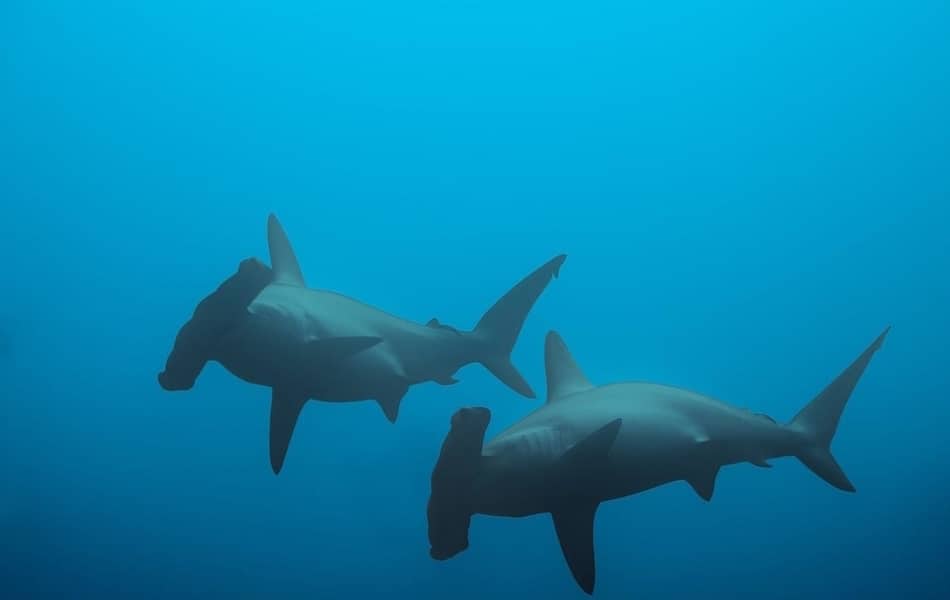
Explore the mysteries and wonders of the sea through scuba diving and snorkeling in one of the world’s top dive spots. Amaze yourself with several volcanic tunnels, various coral reefs, and sea caves.
If the natural habitat is not enough to surprise you, let yourself excite with the views of whale sharks, hammerhead sharks, white tip reef sharks, tiger sharks, silvertip sharks, silky sharks, marbled rays, mantas, dolphins, blue marlin, varieties of fish and snails such as mollusks, crustaceans, yellowfin tuna, sailfish, giant moray eels, octopus, turtles, and more.
Surely, you will exhaust yourself scuba diving with the island’s 20 dive sites to wander and discover its treasures.
The best time to dive here is between June and December . These are some Liveaboards to Cocos Island: Okeanos Aggressor II and Argo .

3. Hike and Swim
Coco’s Island National Park boasts one of the impressive waterfalls in Costa Rica with a swimming pool at the bottom. Don’t worry about getting there because the park rangers will guide you while giving a story about the park’s extraordinary wildlife.
4. Boating and Fishing
If you are not a fan of diving or snorkeling, that’s okay. You can still enjoy the beauty and wonders of the island by boating, fishing, or island hopping. Or you can even just lay on the beach, people watch, wildlife watching, and enjoy the sceneries.
Where to Eat
There are no restaurants in Coco’s Island National Park as it is an isolated island. Therefore, pack something that would last you for days on the island.
Where to Sleep
There are no overnight facilities in Coco’s Island National Park. The only accommodations on the island are the chambers for park rangers. So we recommend you to book your lodging on the nearby areas or from San Jose itself. You may want to try Jaco Royale Hotel, Hotel Punta Leona, Hotel San Bada, Makanda By The Sea, and Terraza Del Pacific Hotel to name a few of the nearby hotels.
Whether you plan for a diving excursion or a nature trekking vacation, Costa Rica’s own Galapagos Island in the name of Coco’s Island National park is the best place to wonder and wander with nature.
The numerous wildlife, marine life, and fauna will bring you to an unimaginative world that some of us didn’t know exists.
As early as now, plan and book your fun adventures to Coco’s Island National Park while the conservation of its remoteness and wildness still hold its value.
The Costa Rica Best Ride Team
Recent Posts
Why is Costa Rica so Expensive? 6 Things that Make it More Expensive Than Other Countries
Costa Rica is a beautiful country with its own unique features. From the capital city, San Jose, to beaches in the Caribbean. It’s a beautiful little country in Central America that is famous for...
Discover 9 best treks in Costa Rica
Known for its amazing natural beauty and bio-diversity, Costa Rica is quickly becoming one of the most popular countries to visit worldwide. Here are the 9 best treks in Costa Rica to have on your...
- Enter Costa Rica
- Attractions
- National Parks and Refuges
- Cocos Island
Cocos Island National Park
Cocos Island National Park: Nestled in the vast expanse of the Pacific Ocean, some 330 miles (523 km) off the coast of Costa Rica, Cocos Island National Park, also known as Isla de Coco, emerges as an unrivaled gem. This pristine sanctuary, just 5 degrees north of the equator, holds a unique status, perched a few hundred miles north of the illustrious Galapagos Islands. Established in 1978, the park is a resolute guardian of unparalleled ecological diversity, safeguarding the habitats vital to marine wildlife, particularly pelagic species, including awe-inspiring sharks. Its exceptional significance led to UNESCO's World Heritage Site designation in 1997. Governed by the Costa Rican government, this natural haven expanded its protective embrace in 2011 with the establishment of the Seamounts Marine Management Area, a sprawling sanctuary five times the size of the existing park. Cocos Island, a beacon for scuba diving enthusiasts , has earned its place among the world's premier dive destinations, boasting over 20 mesmerizing dive sites encircling its shores.
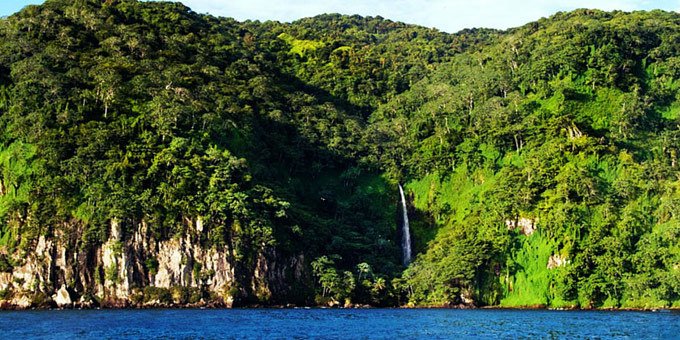
Free Vacation Planning
Cocos island national park: costa rica's subaquatic sanctuary of wonders.
Beneath the Surface: Delve into the depths of the Pacific and uncover the wonders of Cocos Island's underwater realm, a haven where rays, dolphins, and even majestic whales grace your aquatic odyssey. As you explore the warm, azure waters surrounding the island, prepare to be enchanted by a marine ballet of unparalleled splendor. Encompassing Majesty: Cocos Island National Park sprawls across a staggering 199,700 hectares (493,469 acres), a realm that encompasses both the island itself and the protected oceanic expanses that envelop it. This enchanting island spans 2,383 hectares (5,888 acres) and boasts an elevation spectrum ranging from sea level to the majestic summit of Cerro Iglesias, soaring 634 meters above the ocean's surface. The island's interior is a verdant tapestry of mountainous tropical rainforests, adorned with lush ferns, vibrant bromeliads, thriving mosses, and whimsical fungi. Within this landscape, meandering rivers, cascading waterfalls, picturesque valleys, and dramatic cliffs converge in harmonious unity. Marine Marvels: Surrounding this terrestrial Eden lies a marine ecosystem of unparalleled richness, replete with vibrant coral reefs, volcanic tunnels, hidden caves, and the mysteries of the deep. Here, the ocean's symphony is performed by a breathtaking ensemble of diverse species. Yet, with its formidable ocean currents and precipitous drop-offs, Cocos Island's underwater paradise is a realm best explored by experienced divers. Accessible solely via live-aboard boat tours, Cocos Island welcomes those with park ranger permission to explore its captivating shores, though collecting of flora, fauna, or minerals, as well as camping, remains strictly prohibited. Subaqueous Encounters: Underwater enthusiasts will be spellbound by the marine wonders of Cocos Island. Dive into a realm where encounters with white-tip reef sharks and majestic whale sharks are part of the daily spectacle. Over 400 species of coral, an abundance of crustaceans and mollusks, and a mesmerizing array of 300 fish species, including the regal yellowfin tuna and the gentle giant manta ray, coalesce in this mesmerizing aquatic tapestry. Furthermore, the underwater stage sees the grand arrival of humpback whales, pilot whales , playful bottlenose dolphins, and the graceful sea lions. Not to be outdone, hawksbill, green, and olive ridley turtles grace these waters with their presence. Winged Voyagers: Cocos Island's allure extends beyond its aquatic domain, as it beckons avian adventurers with the captivating presence of migratory seabirds. Brown Boobies, Red-footed Boobies, Great Frigatebirds, White Terns, and Brown Noddies elegantly grace the skies. On terra firma, seven species of land birds, including the endemic Cocos Cuckoo, Flycatcher, and Finch—cousins to Darwin's famed finches of the Galapagos—add to the island's ornithological wonder. While two endemic lizard species, an anole and gecko, inhabit the island, amphibians remain elusive. Nonetheless, over 400 species of insects complete this vibrant ecosystem. Cocos Island's wildlife, having evolved in splendid isolation, has given rise to unique endemic species found nowhere else on Earth. A Legacy of Legends: Cocos Island harbors a treasure trove of legends and mysteries, rooted in its captivating history. As the backdrop for documented pirate activity, the island is said to conceal hidden pirate treasure, luring countless adventurers in search of these fabled riches. While small caches have been unearthed, Cocos Island continues to captivate with its enigmatic allure. It is widely believed that Robert Louis Stevenson's "Treasure Island," the desert island in "Robinson Crusoe," and the fictional Isla Nublar in "Jurassic Park" all found inspiration in the mystique of Cocos Island. However, the island faces a pressing challenge in the form of invasive species, such as pigs, goats, and rats, introduced by 18th-century whale hunters. These creatures continue to threaten native species, underscoring the ongoing battle to preserve this ecological jewel.
Cocos Island Facts
Region : Pacific island Closest town : None Size in hectares : 199,700 (493,469 acres) Year established : 1978 Elevation in meters : 0 – 634 (0 – 2,080 feet) Private managed : no Government managed : yes Rangers station : yes Overnight facilities : no Public restrooms : no Entrance fee : $50 Days : daily Hours : 08:00 - 15:30 Hiking trails : no Boat tours : yes Average temperature range in Fahrenheit : 70 - 90 Average yearly precipitation in millimeters : 7,000 Habitat : coral reef, rainforest, beach
From the port of Puntarenas, it is a 32-36 hour boat ride to Cocos Island. Live-aboard boat tours often incude transport to Puntarenas from your hotel in San Jose.
Weather and packing
The climate of Cocos Island is humid and tropical. Temperatures remain the same nearly year round with average day time highs in the upper 80s to low 90s and night time lows in the 70s. Average annual rainfall is 700cm/ 275 inches. Precipitation is high throughout the year, although lower from January through March and slightly lower during late September and October . Depending on your diving preference, calmer seas and better visibility are found between January and May . However the rainier months of June through December are a better time to dive with hammerhead sharks. Annual visitation to Cocos Island is about 1100 people, mainly between March and May.
Visitors should pack a bathing suit, towel, shorts, tee shirts, appropriate shoes, rain gear, sun block, and insect repellent.
Fun Fact: Due to the abundance of documented Pirate activity in the area, Cocos Island is believed by many to be a place to find pirate treasure.
Latitude: N 5° 31' 40.65" Longitude: W 87° 3' 26.71"
Unsure of what to do? Let us make you a free custom trip plan!

Cocos Island National Park in Costa Rica: Guide for Divers
Disclaimer: This article may contain affiliate links. Clicking on them may earn Costa Rica Vibes a commission, at no extra cost to you. Thank you for your support!
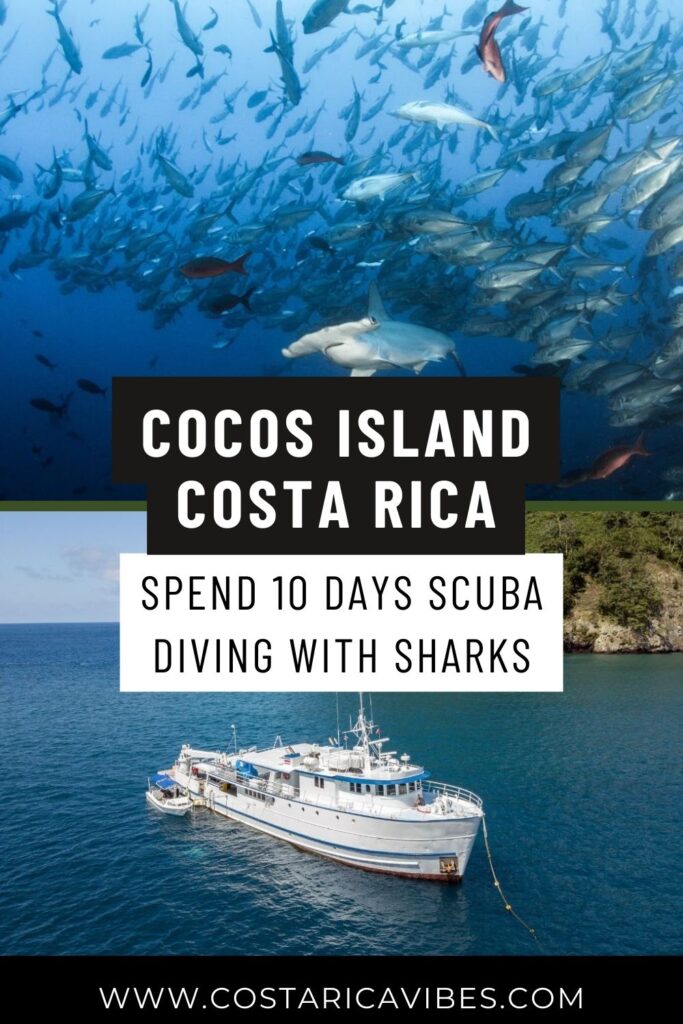
Cocos Island, Costa Rica is a remote island destination on the Pacific Ocean. This is a protected area and part of the Costa Rica national park system. The island is located 300 miles off of mainland Costa Rica and the only way to visit is with a multi-day liveaboard scuba diving tour.
The real draw to this remote destination is the abundance of sharks and other marine life that live in the waters surrounding Cocos Island National Park. If you are passionate in scuba diving, this may be the perfect Costa Rica vacation option for you.
Are you ready to plan your adventure?
Read on for all the details on the best tours, the fascinating history of the island that involves buried treasure, and info about the marine life you might see on your multi-day live-aboard experience.
Just Want to Book Your Trip?
Here are the three best Cocos Island live-aboard tour options
Cocos Island Aggressor
Okeanos Aggressor II
The cocos island diving experience.
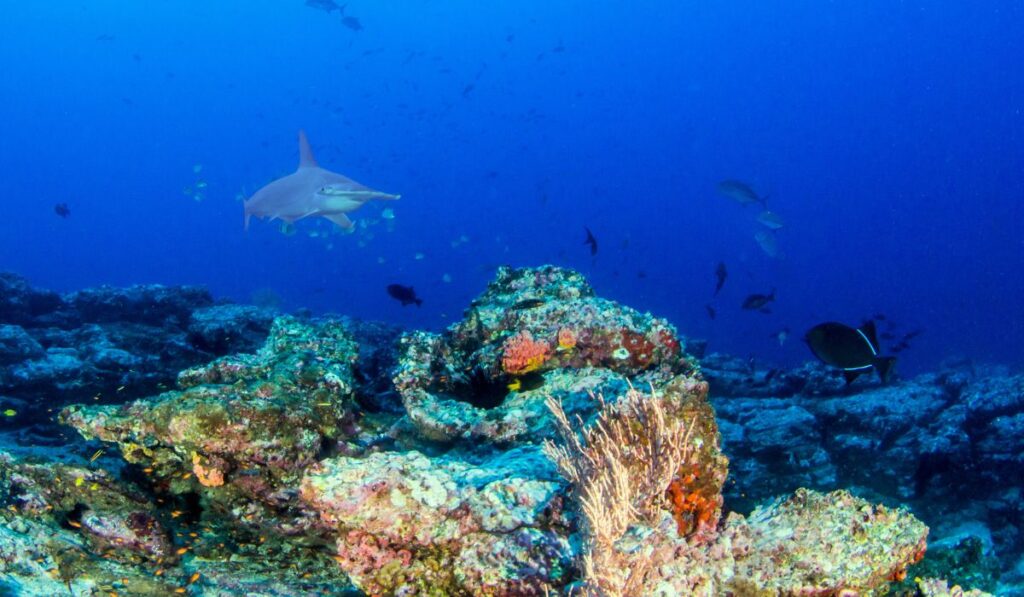
The Cocos Island diving experience starts by boarding a comfortable diving yacht in the city of Puntarenas on the Pacific coast of Costa Rica.
From here, your boat ride out to the island will take approximately 36 hours. It is definitely a very remote location!
You will then spend the next several days visiting diving sites around the island to explore coral reefs and marine life. All meals and sleeping will take place on the comfortable boat.
You will also get the chance to explore Coco’s Island National Park by land as well.
Typically, you will have the chance to dive at 3 different sites per day if you choose.
Marine Life at Cocos Island
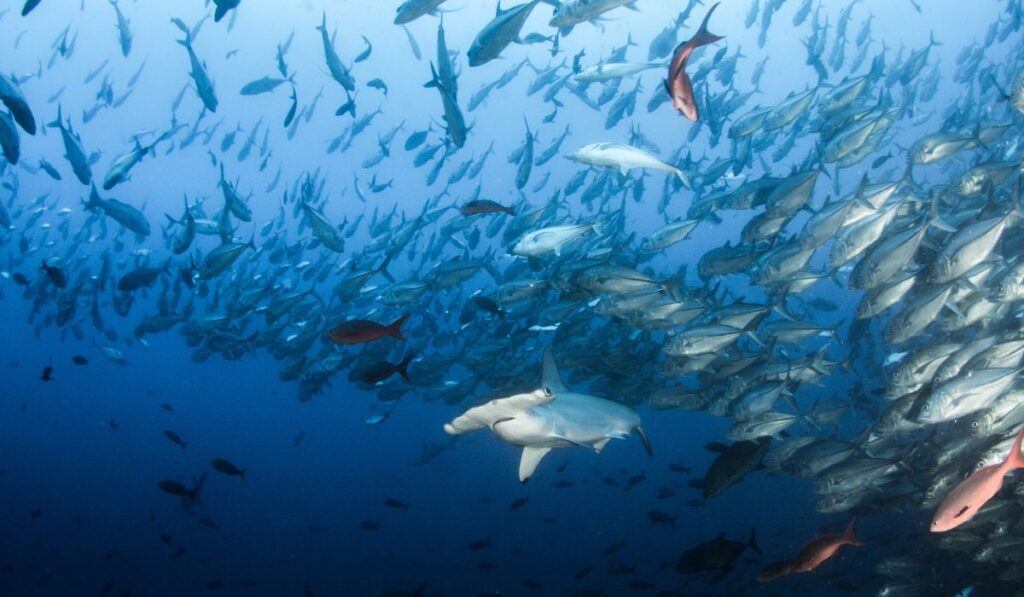
In the waters surrounding Cocos Island, you may see a variety of marine species including:
- Multiple species of sharks including scalloped hammerhead sharks, white tip reef sharks, tiger sharks, whale sharks
- sailfish
- yellowfin tuna
- giant manta rays,
- various species of sea turtles including hawksbill turtles, green turtles, olive ridley turtles
- humpback whales,
- orca whales
- bottlenose dolphins
- Over 300 species of fish
- 30 species of coral
- Over 60 species of crustaceans
- 600 species of mollusks.
🤿 Check Availability and Arrange Your Cocos Island Trip 🦈
Cocos Island Diving Sites
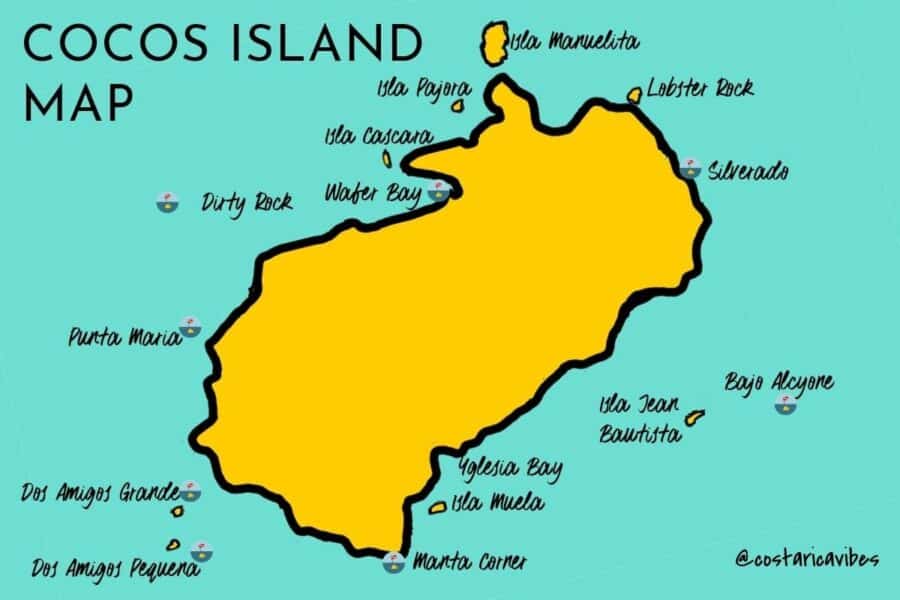
There are several dive sites that you will visit during your trip. Here are the main marine area highlights.
Bajo Alcyone
This is a great spot to see hammerhead sharks.
The seamount top is about an 82ft (25m) descent. From here, you can find a crevice to hang out and watch the hammerheads come into view in swarms. You will likely see hundreds of them. In this area, you might also see silky sharks and whale sharks.
The reef isn’t overly impressive, but there is some sea life with octopi and manta rays.
This is considered the most popular diving spot in the area due to the volume of hammerheads and the large amount of fish that gather here. You may see tuna, blacktip sharks, snapper, bigeye jacks, whale sharks, and more!
The area is made up of volcanic rock outcrops that are divided by a seed channel.
Dos Amigos Grande
Here there is an impressive underwater arch. This can be accessed at 82ft (25meter). Here you can see hammerheads, reef sharks, eagle rays, jacks, snapper, etc.
Occasionally, tiger sharks have also been known to show up in this area.
🤿 Check Availability and Arrange Your Diving Adventure 🦈
Dos Amigos Pequeña
This small island is a nice spot to swim around and see sharks, urchins, snappers, and starfish. This is an area of great visibility.
Manuelita Deep
There are numerous ledges in this area where white tip reef sharks often hang out. Just note that this area can have strong currents.
This is one of the more popular diving sites and is sometimes visited more than once on liveaboards.
Manuelita Garden
Manuelita Garden is a coral garden located atop a submerged mountain. This is one of the only coral reef dives near Cocos Island, and it is beautiful!
Visiting the Island’s Mainland
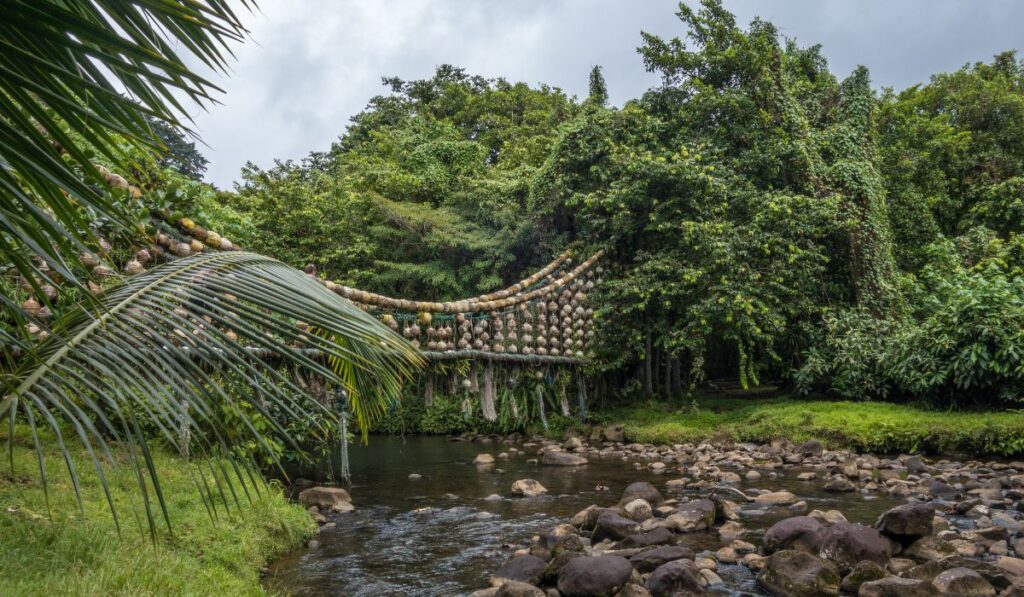
During your several days of diving at the Isla del Coco National Park you will have a few opportunities to walk with a park ranger on the island. There is a waterfall that you could previously walk to, but I read that it is now closed to visitors.
Along the way, you may see wild boars, goats, white-tailed deer, two species of rats, and house cats, over 90 species of birds including red-footed boobies, brown boobies, and Cocos finch and various species of insects.
Keep in mind that the government of Costa Rica has made this island into a national park . The only people who live out here are the national park rangers. The only people allowed to step foot on the land are people visiting on liveaboard diving tours.
History of Cocos Island
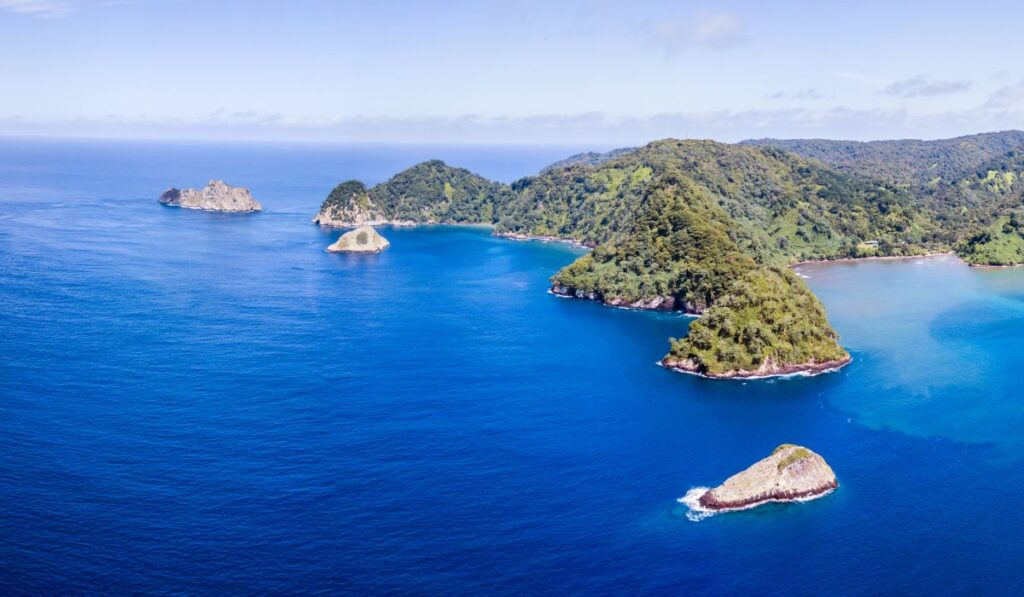
I’ve got to admit, the history of Cocos Island is one of my favorite histories in Costa Rica. It is so fascinating and it involves billions of dollars in buried treasure!
Cocos Island was annexed by Costa Rica in 1832. During this time and until the mid-19th century, whalers regularly stopped at the island.
In October 1863, a few hundred Tongan former slaves were abandoned on the island after it was discovered that they had contracted smallpox. The crew did not want to be affected, so they deserted them.
By the time the Tongans were rescued one month later only 38 people remained. The rest had died from smallpox.
The island was established as a national park in 1978.
In 1997 it became a UNESCO World Heritage Site.
In 2002 that classification was expanded to include over 700 miles of ocean surrounding the island.
And, in 2022 the president of Ecuador announced the expansion of the Galápagos Marine Reserve by 50%. This addition added 23,000 sq miles of protected sea and land to the northeast of the islands.
This means, the protected oceanic area around Cocos Island now connects all the way down to the Galapagos Islands.
Buried Treasure
The island is sometimes referred to as Treasure Island, and for good reason!
There are multiple claims of buried treasure on the island, but none has actually been discovered (that we know of).
The first claim came from a woman, Mary Welch in 1818. She stated that 350 tons of gold (worth $16 billion today) was buried on the island by a British pirate named Bennett Graham. She claimed that she had been a member of the pirate crew and knew that this cache had been stolen from a Spanish galleon and buried there.
Welch was sentenced to an Australian penal colony for her crimes. However, when she was released she returned to Cocos Island with a map which she claimed showed the location of the treasure.
Unfortunately, the landmarks were unrecognizable and she never found the treasure.
A Portuguese pirate, Benito Bonito also supposedly buried treasure on the island around the same time as Bennet Graham, but no concrete evidence has been found.
The most well-known legend of Cocos’ treasure comes from what is referred to as the Treasure of Lima. The Spaniards controlling Lima, Peru in 1820 supposedly entrusted a British trader, Captain William Thompson, with the city’s treasures while Lima was being invaded by the Argentinian army.
Thompson and his crew allegedly took off with the treasure and sailed to Cocos Island where they allegedly buried the loot. Not long after, they were stopped by a Spanish warship that killed the entire crew except for Thompson and his first mate.
They promised to show the Spanish crew the location of the buried treasure on the island in exchange for their lives, but both Thompson and his first mate ran off into the thick jungle as soon as they landed onshore.
The treasure was never found.
In 1897, a small colony was formed here under the rule of a German adventurer. This colony was short-lived, but while here the adventurer spent a great deal of time searching for the supposed buried treasures. He found a few gold coins., but nothing else
Since then, there have been over 300 hundred expeditions to find the buried treasures that the island may possess, but none have been successful so far.
And, because the Costa Rican government decided to make the island a protected area that is not open to the public it is not a heavily traversed piece of land except for by the park rangers.
Best Time of Year to Visit
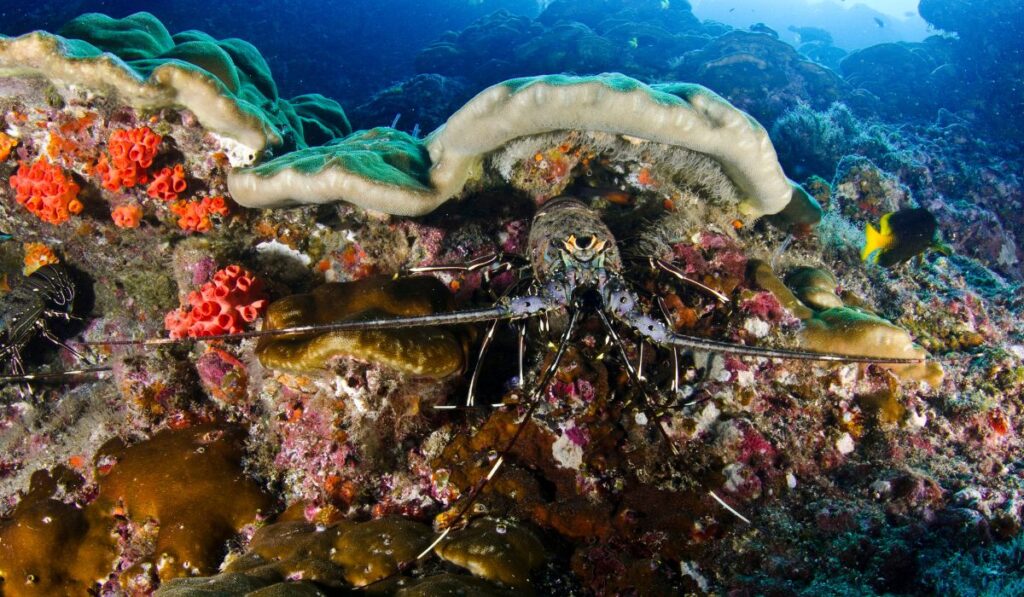
The dry season (mid-December until end of April) is the best time to visit for good weather and clear visibility. There will be almost no rain during this time of year.
This is the best time to visit if you have a tendency to get seasick because the waters will be much calmer.
The rainy season (May until mid-December) means almost daily rain storms usually in the afternoon. During this time of year, the water may be much rougher. However, this is the best time to see hammerhead sharks and manta rays.
If possible, we suggest visiting in mid-July . Usually, Costa Rica experiences a mini summer during this time of year and the rain stops for about two weeks. This also happens to be when hammerhead sharks are about at their peak.
Diving Conditions
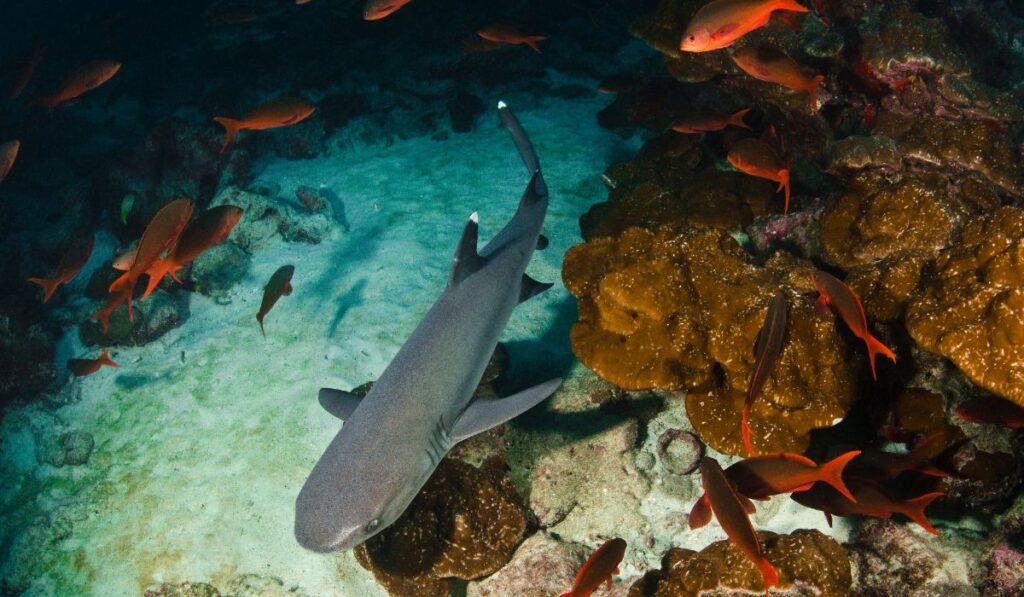
Most of the diving sites are open water. Keep in mind that many of the diving sites are located on submerged mountains and can have strong currents depending on the time of year.
The water temperature is usually between 75 and 85 degrees Fahrenheit.
🤿 Arrange Your Cocos Island Diving Adventure 🦈
The visibility is generally between 30 and 100 feet. Most dives are between 30 – 131 feet (10 – 40m).
For this reason, Nitrox diving is recommended.
What to Pack for the Liveaboard Experience
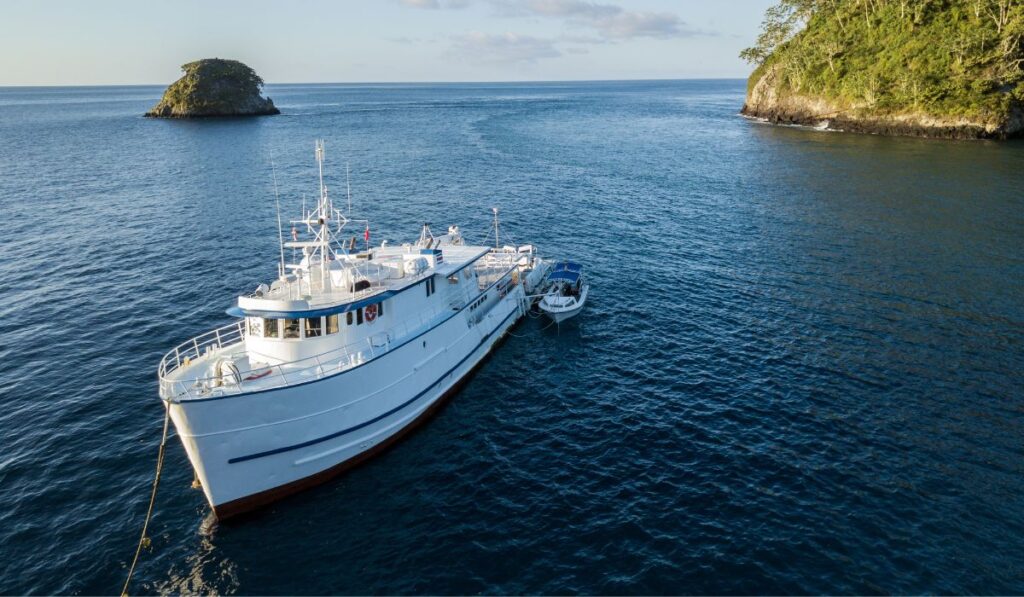
It is recommended that scuba divers bring:
- Reef-safe sunblock
- Comfortable clothes for while on the boat
- Dive computer
- snorkel gear
- wetsuit (between 3 and 5mm)
- dive gloves
- depth gauge
Tanks, weights, and weight belts will be provided on the boat.
We suggest that you put all of your gear in luggage designed for diving gear . This will help keep everything secure and well packaged.
If needed, it is always possible to rent all equipment on the boat for the extent of your diving adventure. This will save you from the hassle of lugging everything with you.
Also, laundry service is available on most boats.
PADI Requirements
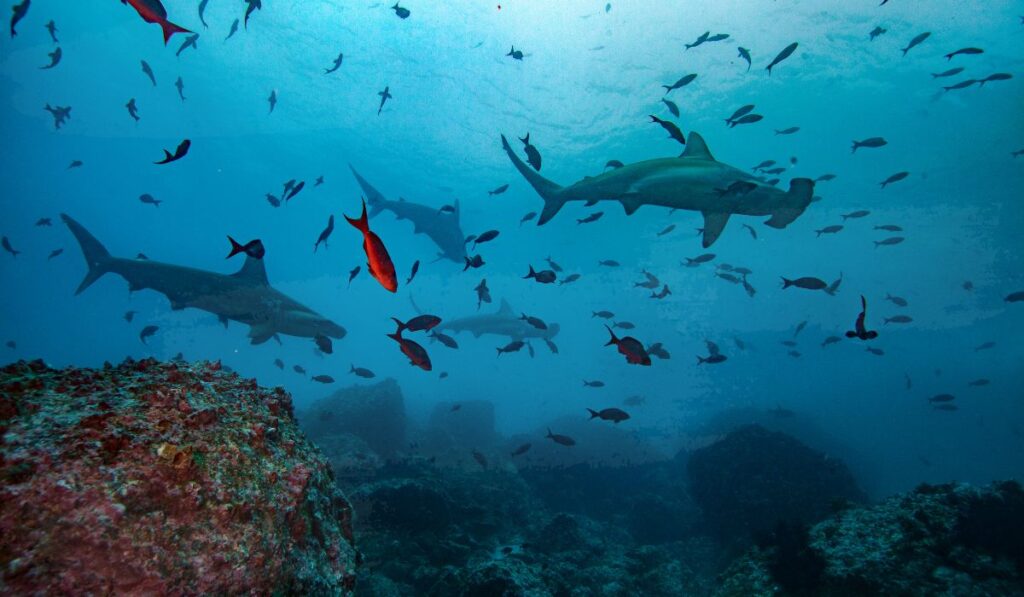
We recommend this trip to more experienced divers. It is a full immersion into diving and if it is not something you are super passionate about, it may be a bit much for you.
However, for most tours, the only requirement is that you have your PADI open water certification.
There is no requirement for the number of dives completed, but 50 hours of completed dive time is highly suggested.
Most tours will offer the Enriched Air Nitrox course for an extra fee.
Safety Notice
All tours and dives are led by certified guides with extensive training. That being said, occasionally things happen.
I say that because a woman from New York was killed here in 2017 during an unprovoked tiger shark attack.
Her diving instructor was also bit in the leg but survived the attack.
Tiger sharks in the area are a relatively new thing and are very rare.
Cocos Tour Options
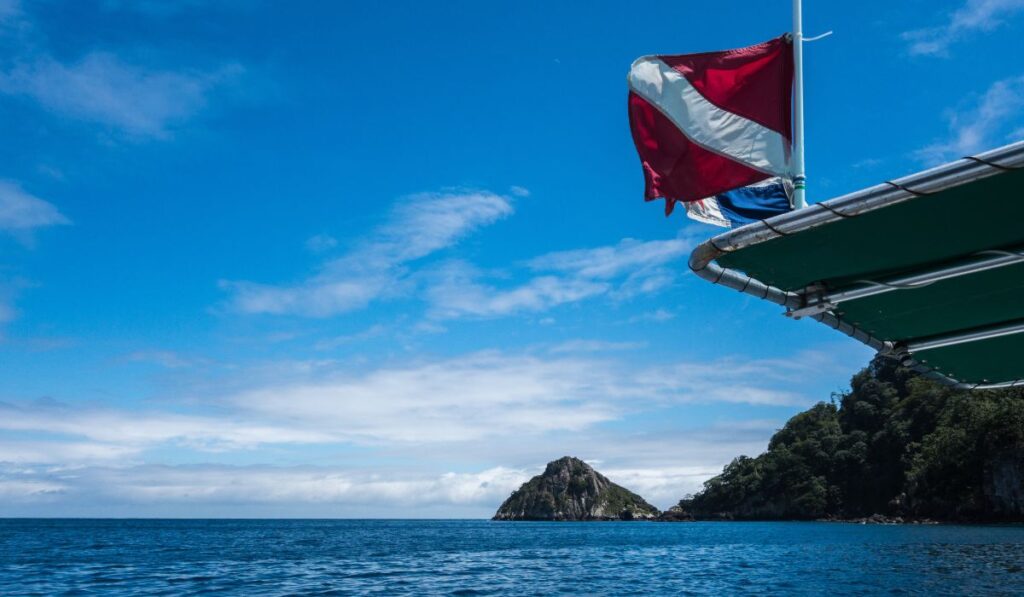
In order to visit Cocos Island it is necessary to take a multi-day liveaboard-style boat trip. This is due to the fact that it is located over 300 nautical miles off of Costa Rica’s coast and the fact that nobody besides park rangers are allowed on the actual island (they are trying to keep all the buried treasure for themselves 😉 ).
The boat trip out to Cocos Island from the Puntarenas port takes between 36 to 48 hours.
All liveaboard boats will anchor it the bay off of the island at night. Staying on the island is not permitted.
There are multiple tour options. Here are the best options.
MV Sea Hunter
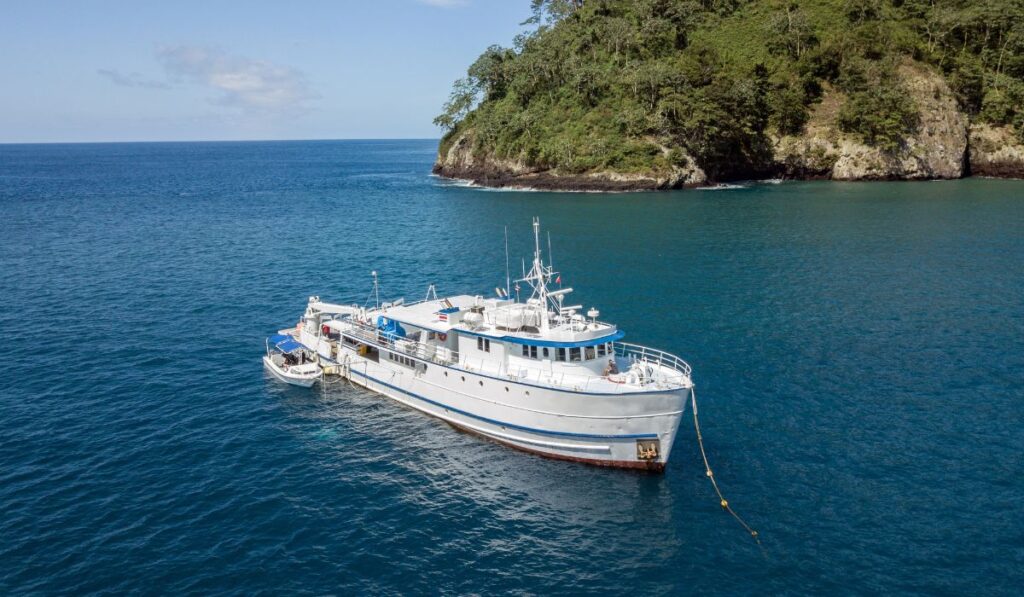
⭐️ RATING: 9.3 on LiveAboard | ⏳ TOUR LENGTH: 10 to 11 days | ✅ Book it!
This boat has 10 cabins which accommodates 20 guests in twin and double bed air-conditioned suites. All rooms have en-suite bathrooms. The boat has an air-conditioned restaurant, sundeck, entertainment lounge, and a study with books.
Tour Length
Tours vary between 10 and 11 nights
Tour Schedule
Plan your flight to fly in and out of the San Jose International Airport . You will need to organize your own transportation from the airport to your hotel in San José for the first night.
The next morning, the boat’s crew arranges to pick up only from these 4 hotels: Grano de Oro , Park Inn, Hampton Inn , and Costa Rica Marriott , so you will need to book your stay at one of those places.
A sample itinerary based on the length of your trip is as follows….
Day 1: Meet in front of the host hotel in San Jose. A transfer service to Puntarenas will be provided. Along the way, you will stop for a snack and lunch. You will then board the boat and depart for Cocos Island.
Day 2: It will take approximately 36 hours to arrive at Cocos Island.
Day 2-9: These days will consist of eating, sleeping, and diving around the multiple island diving sites. Meals will be provided throughout the day. Most days consist of three dives, but three times during the trip there will be an option for a night dive as well.
Day 9-10: Travel back to Puntarenas.
Day 11: Check out of the boat at 8am. A transfer bus will take you back to San Jose Airport or host hotels.
In addition to the liveaboard rate you will also need to pay
- National Park Fee – USD 553 (to be paid in advance)
- Fuel surcharge – USD 200 per person (to be paid onboard)
🤿 Check Availabilit y for MV Sea Hunter 🦈
Okeanos Aggressor
⭐️ RATING: 8.4/10 on LiveAboard | ⏳ TOUR LENGTH: 10 nights | ✅ Book it!
This is a brand-new yacht that was built in 2022. It is a beautiful mix of luxury and practicality.
- 10 nights accommodation
- 7 days of diving (3-4 dives per day)
- Snacks, soft drinks, water, tea, coffee, local beer and wine
- 12l tanks and weights
- Scheduled group transfer from San Jose to yacht terminal
- Free short-term DAN diving insurance (upon request)
This yacht accommodates 22 guests in 5 deluxe staterooms and 4 master staterooms.
Each room has an individually controlled AC, TV and media player, bathroom, and ample storage space. All meals are served in the dining room.
The food consists of freshly prepared local cuisine, American, and BBQ. There is a large salon with entertainment options as well as a sun deck with lounge chairs, a hot tub and a shaded cocktail deck. All food and drinks are included in the price.
11 days/ 10 nights
Plan your flight to fly in and out of the San Jose International Airport .
The organizers of this trip would like you to spend your first and last night at the Park Inn in San Jose if possible. This makes it easy for them to pick you up in the morning.
You can book your stay at the Park Inn here
You will need to arrange your own transportation from the airport to Park Inn. We suggest just getting a registered taxi from the airport.
Day 1: Meet in front of Park Inn. A transfer service to Puntarenas will be provided. This drive takes about 1.5 hours. You will then board the Aggressor and depart for Cocos Island.
Day 2-3: Arrive to Cocos Island and begin diving.
Day 4-8: These days will consist of eating, sleeping, and diving around the multiple island diving sites as well as visits to the island for nature exploration.
Day 11: Check out of the boat at 7 am. A transfer bus will take you back to San Jose Airport or Park Inn hotel.
On top of the diving tour price, you will need to pay for any gear that you need to rent, Cocos Island Park Fee to be paid on board (USD 490 per person + 13% VAT), Cocos Island Emergency Evacuation Plan – USD 30 per person (to be paid on board).
Also, flights, hotel on the first and last night, Nitrox, and crew gratuities are not included.
🤿 Check Availabilit y for Cocos Island Aggressor 🦈
⭐️ RATING: 8.6/10 on LiveAboard | ⏳ TOUR LENGTH: 10 nights | ✅ Book it!
This yacht accommodates 22 guests in 11 cabins. All meals are served in the dining room and consist of freshly prepared American style cuisine.
There is a large salon with entertainment options as well as a sun deck with lounge chairs and a bar and grill. All food and drinks are included in the price.
The organizers of this trip would like you to spend your first and last night at the Park Inn.
You will need to arrange transportation from the airport to Park Inn. We suggest just getting a registered taxi from the airport.
Day 1: Meet in front of the host hotel. A transfer service to Puntarenas will be provided. This drive takes about 1.5 hours. You will then board the Okeanos Aggressor ii and depart for Cocos Island.
Day 4-8: These days will consist of eating, sleeping, and diving around the multiple island diving sites..
Day 11: Check out of the boat at 7 am. A transfer bus will take you back to San Jose Airport or host hotels.
🤿 Check Availabilit y for Okeanos Aggressor ii 🦈
Things You Should Know Before Booking
Here are all of our helpful travel tips that your should know before booking your liveaboard adventure to Cocos Island.
There are Multiple Places Called Cocos Island
Don’t get confused when booking your trip. There is also a series of islands in the Indian Ocean called Cocos Islands.
These islands are part of Australia and are sometimes also referred to as “Cocos (Keeling) Islands” or Cocos Islands Malay.
Don’t Forget Travel Insurance
Make sure to purchase a travel insurance plan which will cover you for accidents related to diving.
Conservation Efforts
Conservation of this area is very important. Please be careful not to destroy or take any part of the natural habitat. Leave to trace of your visit except your amazing memories.
Conclusion: Scuba Diving Cocos Island
In conclusion, Cicos Island is a beautiful place with a diverse marine ecosystem. A scuba diving adventure here is bound to be an extremely memorable experience.
So, what do you think? Is a diving trip to Cocos Island in your future? If you have any questions, feel free to comment below. We are always happy to help you out!
You Might Also Like:
The 10 Best Spots for Snorkeling in Costa Rica
Fishing in costa rica: charters, shore fishing, and more, 60 things to do in costa rica – for all budgets and interests, costa rica catamaran tours: how to arrange a trip, costa rica excursions – plan day tours.
Costa Rica Travel Details : What You Need to Know
🚗 Should I rent a car in Costa Rica?
Having a rental car will give you the most flexibility when traveling in Costa Rica. This will also allow you to take fun day trips on your own.
- Save 10% Plus Other Perks with Our Adobe Rental Car Discount
- You might also consider; shared shuttle services or private transfer services
🏄🏽 How can I book things to do?
We find that Viator tends to have the most comprehensive selection of activities with secure booking and good cancellation policies.
🍍 I’m overwhelmed with planning. Can you help?
Of course! I suggest joining our Facebook group for specific questions and head to our Start Here Page to get started planning.
✈️ What is the best way to book a flight?
Usually, we have the best luck finding great prices with Skyscanner . Check for flights to both San Jose Airport (SJO) and Liberia Airport (LIR).
🛏️ What is the best way to book my Costa Rica hotels?
We highly suggest Booking.com for hotel bookings and typically use VRBO for Costa Rica vacation rentals.
🗣️ What is the main language in Costa Rica?
The main language in Costa Rica is Spanish. Most people working in tourism speak at least some English.
💰 What is the currency in Costa Rica?
The currency used in Costa Rica is the Costa Rican colón (CRC). However, the US dollar is widely accepted in most tourist areas
📞 What is the best way to stay connected?
An eSIM from Airalo is the easiest way to get 4G data while traveling in Costa Rica.
🌴 Is Costa Rica safe?
Generally, Costa Rica is considered safe for tourists. However, like any travel destination, it’s best to use caution and be aware of your surroundings.
🛂 Do you need a passport to go to Costa Rica?
Yes, Costa Rica is its own country. You will need a passport to visit.

Hi! We’re Thomas (the German) and Sarah (the US-er)
We met in Virginia, moved to Germany, and since 2016 we have lived in sunny Costa Rica. It was a spontaneous decision to move here, but it was the best decision! Now we spend our days roaming the country to bring you the very best in Costa Rica travel here on Costa Rica Vibes. Sarah is the writer. Thomas is the one keeping it all together. Want the whole crazy story?

Sarah McArthur
Sarah McArthur is the co-founder and main writer of Costa Rica Vibes. She is originally from the United States but has lived in sunny San Jose, Costa Rica since 2016. She has traveled all over the country and now considers herself a self-proclaimed Costa Rica travel expert. Want the whole crazy story?
Leave a Reply Cancel reply
Your email address will not be published. Required fields are marked *

Shop All The Costa Rica Packing Essentials
- Find Your Trip
- Vacation Ideas
- Travel Tips
Customized Costa Rica Vacations, since 1999.
Cocos Island
The mecca for divers a remote, stunning island destination on the pacific ocean in costa rica..
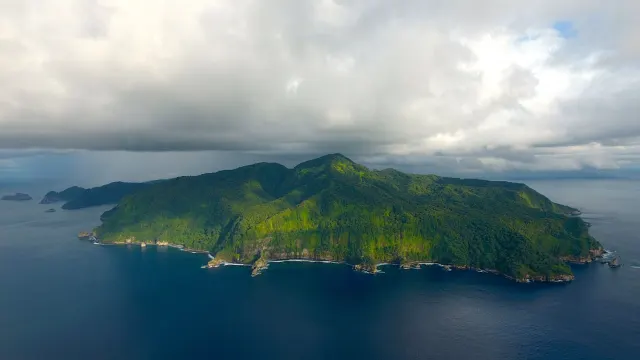
Cocos Island at a Glance
- Ideal for: Seasoned divers, adventure seekers and n ature lovers.
- Nearby activities: Scuba diving, wildlife watching, hiking and sportfishing.
- Main dive spots: Bajo Alcyone, Dirty Rock, Dos Amigos Grande, Everest, Manuelita Coral Garden (night dives).
Special Features:
We live, work & travel in Costa Rica.
Every trip is designed for you.
5,000+ reviews from dazzled guests.

Cocos Island

Cocos Island, Costa Rica
Pacific Ocean Area: 23.52 kms2 Area de Conservacion Marina Cocos
Isla del Coco is located in the Costa Rican Pacific Ocean, at an approximate distance of 532 km / 330 miles southwest of Cabo Blanco, Nicoya Peninsula. The Cocos Marine Conservation Area (ACMC) is one of the eleven Conservation Areas that make up the National System of Conservation Areas (SINAC) of the Republic of Costa Rica. Its mission is to observe the ecosystems of the ACMC, through the execution of an adequate management of its natural resources, and to constantly increase its knowledge and that of its area of influence.
This National Park was created in 1978, it has been declared a World Heritage Site by UNESCO since 1997. Due to its characteristics, Coco Island is one of the most privileged natural sites worldwide. It is recognized as a reservoir of biodiversity and endemism, a site of exceptional scenic beauty. The blue-turquoise water is extraordinarily clear and makes a great habitat for an abundance of marine life, making this island one of the most extraordinary places in the world for diving. It also has beautiful evergreen forests and numerous impressive waterfalls.
When visiting Coco's Island National Park, tropical animals and exotic avian and marine life are just a few of the attractions that magnetize travelers visiting this beautiful island. A trek through the national park will likely expose visitors to many kinds of wildlife that are so rare, they cannot be located anywhere else on the planet. In the nearby water, 270 kinds of fish are abundant, and a snorkeling adventure provides an intimate view of their variety. These exceptional finds are conventional discoveries in Cocos Island National Park fauna. The phenomenal flora is exhibited by the 235 breeds of plants that punctuate the island’s versatile landscape.
Volcanic transformation has carved cliffs and valleys into the island landscape, creating a spectacular panorama. The absence of colonization has helped to preserve the island’s stunning and pristine composition. This lack of human settlement means that there are no hotels, hostels, or cabins for overnight stays on the island. The intent is for Coco’s Island to remain a preserved sanctuary for wildlife and maintain an unsullied view for travelers in search of nature’s secrets. For visitors, there is an information center, a park ranger’s station, trails, signage, restroom services, potable water and several lookout points.
The island is accessible exclusively by boat. From the Port of Puntarenas you can reach Isla del Coco National Park by boat. The trip takes about 36 hours. The park is open all year, every day of the week. There are two sectors: Bahía Wafer and Bahía Chatham. Snorkeling is a favorite pastime. For visitors, there is an information center, a park ranger’s station, trails, signage, restroom services, potable water and several lookout points.
Contact our Cocos Island, Costa Rica Vacation Guides today by visiting our Costa Rica Trip Planner !


Scuba divers swim through a sea cave with schooling grunts off Cocos Island, Costa Rica.
Must-Do Trip: Dive Cocos Island, Costa Rica
Ultimate Adventure Bucket List: Explorer Enric Sala's dream trip is to dive Cocos Island, Costa Rica. See all our Adventure Bucket List trips.
Three hundred miles—and a 36-hour boat ride—southwest of mainland Costa Rica , a lush volcanic island rears up improbably out of the Pacific Ocean. Cocos is at once a geological anomaly, a stopover for big pelagics like sharks, rays, and whales, and a divine gift for recreational divers willing to make the schlep. “It's the last place where one can always see big schools of large fish, including hammerhead sharks, whitetip sharks, and trevally,” says Enric Sala . At the dive site Dos Amigos Grande, divers swim through an enormous underwater arch and see schools of hammerheads and mating eagle rays, or at Manuelita, a night dive might reveal hundreds of darting whitetip sharks. “It’s hard to find another place in the ocean with the same tons of large animals per hectare,” says Sala. “If it's not a school of 200 hammerhead sharks, it is a bait ball attacked by Galápagos sharks, dolphins, and seabirds.” Undersea Hunter Group offers ten-day liveaboard dive trips to Cocos Island from San Jose, Costa Rica starting at $4,895. Next: See Enric Sala's Dream Trip: Dive the Poles
See the Ultimate Adventure Bucket List 2011
- Nat Geo Expeditions
FREE BONUS ISSUE
Related topics.
- SCUBA DIVING
- ADVENTURERS
You May Also Like

Get ready for your next iconic adventure like a pro with these tips


The most dangerous job on Earth? Inside the world of underwater welders

Max Leonard treks back in time along the mountainous Italian-Austrian border

Essential kit for kayaking, from waterproofs to reliable paddles

The top 3 adventures in The Florida Keys & Key West
- Environment
- Perpetual Planet
History & Culture
- History & Culture
- History Magazine
- Mind, Body, Wonder
- Paid Content
- Terms of Use
- Privacy Policy
- Your US State Privacy Rights
- Children's Online Privacy Policy
- Interest-Based Ads
- About Nielsen Measurement
- Do Not Sell or Share My Personal Information
- Nat Geo Home
- Attend a Live Event
- Book a Trip
- Inspire Your Kids
- Shop Nat Geo
- Visit the D.C. Museum
- Learn About Our Impact
- Support Our Mission
- Advertise With Us
- Customer Service
- Renew Subscription
- Manage Your Subscription
- Work at Nat Geo
- Sign Up for Our Newsletters
- Contribute to Protect the Planet
Copyright © 1996-2015 National Geographic Society Copyright © 2015-2024 National Geographic Partners, LLC. All rights reserved
Cocos Island National Park

- 1.1 History
- 1.2 Landscape
- 1.3 Flora and fauna
- 1.4 Climate
- 3 Fees and permits
- 4 Get around
- 11 Stay safe

Cocos Island is a nationally protected jungle-covered island and national park off the coast of Costa Rica . It's also a UNESCO World Heritage site .
Understand [ edit ]
Cocos Island is in the Eastern Tropical Pacific approximately 300 mi (480 km) southwest of Cabo Blanco, Costa Rica. A rugged and incredibly beautiful island, today Cocos Island is the most sacred National park in Costa Rica's extensive park system.
Among Cocos Island's many attributes is a startling degree of biodiversity. This island's world-renowned waters explode with life, including innumerable white tip reef sharks, schooling hammerhead sharks, dolphins, mantas and marbled rays, giant moray eels, sailfish, and of course the occasional whale shark. Other common encounters are large schools of jacks and tuna, silky sharks, silver tip sharks, marlin, Creole fish, green turtles and octopus. On the Island you will encounter a lot of pigs and not much else besides the usual vegetation.
History [ edit ]
The island is supposed to hold three of the largest treasure troves of all time. From pirates to the entire horde of Lima which was hidden there from Simon Bolivar and his troops in 1821.
Landscape [ edit ]

Cocos Island is a very hilly, dense tropical jungle with over 200 waterfalls and averages over 400 in (10,000 mm) of rain a year. It has three bays and is 24 km² of land.
Flora and fauna [ edit ]
Climate [ edit ].
Is hot and very humid. Expect showers lasting a few hours most days between March and December.
Get in [ edit ]
As tourists are allowed ashore only with permission of island rangers, there are very limited ways to be able to step foot on the island but one of the best ways to experience this natural beauty is through a dive trip. There are two fully equipped dive boats that do week-and-a-half trips out to the island and back, they are the Okeanos Aggressor [formerly dead link] and Undersea Hunter [dead link] .
Fees and permits [ edit ]
In order to set foot on the island with the intent of treasure hunting requires a permit from the Costa Rican Government. This is because of the large numbers of treasure expeditions that have been seen come through the island over the last 50 years. Over 400 large scale expeditions have been assembled along with tens of thousands of smaller and independent searches.
Get around [ edit ]

Getting around the island is a little tricky. The main types of transportation are by foot or bike usually used for hikes and sight-seeing tours. The few locals who live here mainly use foot, or bike, or small motor bikes and dirt bikes.
See [ edit ]
Since this is an island you will see a lot of ocean, but if you ever get the chance to step foot on the island and are somewhat physically fit, hike to the top of the island with a guide. It is a magnificent view.
Do [ edit ]
The main attraction for Coco island is its unbelievable scuba-diving with its schooling hammerhead sharks. On the island hiking and biking to the top of the island for the spectacular view is an almost must. Other main activities include snorkeling, island hopping, and fishing the waters surrounding the island. Many people go to Cocos just to relax on the beach and enjoy the scenery.
Buy [ edit ]
Eat [ edit ], drink [ edit ], sleep [ edit ].
Tourists and are not permitted to stay on the island.
Stay safe [ edit ]
The only possible dangers in Cocos Island are the sharks, eels, and other creatures that might be seen while diving, snorkeling, boating, or fishing.
Go next [ edit ]
- UNESCO World Heritage Sites
- UNESCO tag to be fixed
- Articles without Wikipedia links (via Wikidata)
- Has custom banner
- Articles with formerly dead external links
- Articles with dead external links
- Has Geo parameter
- All destination articles
- Outline parks
- Outline articles
- Park articles
Navigation menu
Most popular inspiration
Most popular experiences
Most popular destinations
Most popular itineraries
Travel bucket list idea:
Dive with hammerhead sharks at Cocos Island
Cocos Islands, Puntarenas Province, Costa Rica
Bucket List Experience
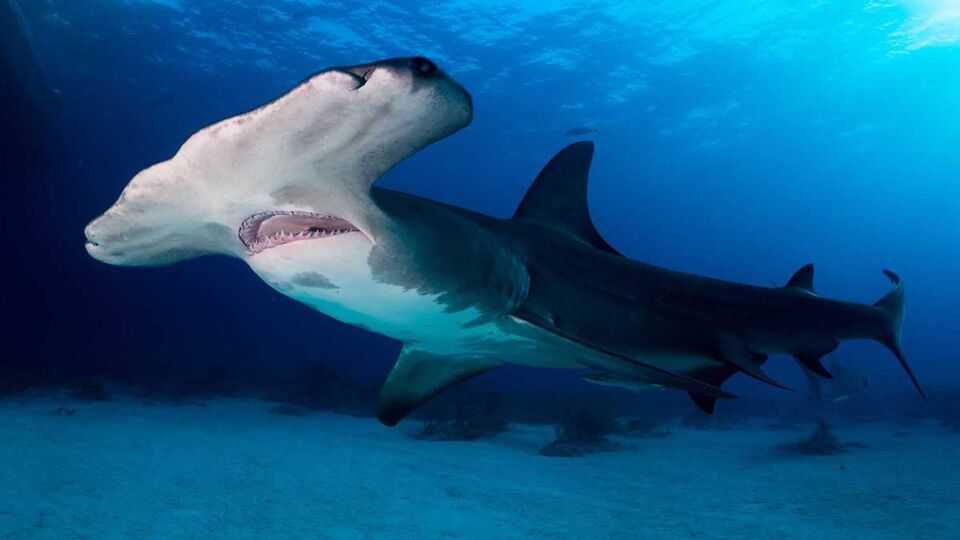
Cocos Island, in the deep Pacific, some 550km off the Costa Rican coast, is one of the top dive destinations in the Americas and together with the Galapagos one of the best destinations for marine wildlife in the Eastern Pacific.
It’s also the site of one of the great underwater spectacles – the mass schooling of hundreds of hammerhead sharks.
Each year, from June through October, they gather in uncountable numbers, attracted by high concentrations of prey. Cocos Island sits at a convergence of swirling, nutrient-rich currents, attracting vast schools of fish on which the hammerheads feed.
Whale sharks are also regular visitors to the waters around Cocos, making it a popular location for wildlife filmmakers.
Are hammerhead sharks dangerous?
Although officially tagged as a ‘man-eater’, hammerheads are shy of humans and attacks are extremely rare. They hunt on the ocean floor at night, feeding on stingrays (their favourite food), squid, mackerel, sardines and octopus.
Why do they have a strange-shaped head?
Their strange hammer-shaped head contains hundreds of small electrical sensors that they use to detect the faint electromagnetic fields generated by their prey hiding beneath the sand.
Getting there & doing it
The only way to reach the islands is on an 11-day liveaboard dive trip. Two boats run by Under Sea Hunter leave from Puntarenas – the Seahunter (for up to twenty) and the newer Argo (with space for 18), all in private cabins. The boats are very comfortable with large lounge areas, rooftop sundecks, powerful RIBs and state-of-the-art dive equipment including Nitrox, rebreather facilities and zero-speed stabilizers.
The Cocos is open water oceanic diving. All divers require a minimum Open Water with the Deep Diver Specialty level of PADI or equivalent certification, dive insurance and a recommended 25 hours of diving experience.
When to do it
Diving trips run all year round. June through December is the best time to see the hammerheads and whale sharks, but the seas are rougher. December to May is better for diving with dolphins and manta rays.
Who to go with: tour operators
Our writer’s recommended tour operators to book with
Undersea Hunter
Puntarenas, Costa Rica
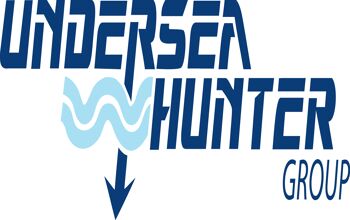
Offers 11-day liveaboard dive boat expeditions to the Cocos islands all-year-round. Trips include diving with hammerheads sharks.
Destination guides
Destination guides including or relevant to this experience
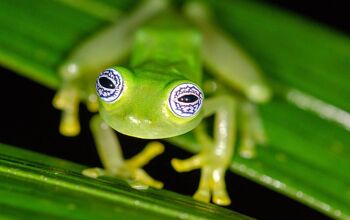
Destination guide
Rainforests, powdery beaches, white-water rivers and towering volcanoes: this relaxed Central American country offers exceptional wilderness adventures in stunning landscapes.
Round-ups that include this experience
55 Breathtaking natural wonders of the world
Multiple countries

Inspiration
Former travel editor of BBC Wildlife Magazine James Fair round-ups the earth’s greatest natural wonders, which will literally take your breath away.
13 Best places to swim with sharks
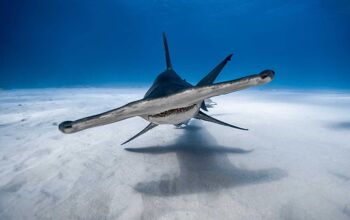
Get in the water with the so-called ‘man-eaters’ – great whites, tiger, bull and hammerhead sharks – to appreciate these magnificent but sadly maligned creatures .
Take advantage of the search to browse through the World Heritage Centre information.
Share on social media
Unesco social media, cocos island national park.
- Description
Cocos Island National Park, located 550 km off the Pacific coast of Costa Rica, is the only island in the tropical eastern Pacific with a tropical rainforest. Its position as the first point of contact with the northern equatorial counter-current, and the myriad interactions between the island and the surrounding marine ecosystem, make the area an ideal laboratory for the study of biological processes. The underwater world of the national park has become famous due to the attraction it holds for divers, who rate it as one of the best places in the world to view large pelagic species such as sharks, rays, tuna and dolphins.
Description is available under license CC-BY-SA IGO 3.0
Parc national de l'île Cocos
Le parc national de l'île Cocos, situé à 550 km au large de la côte pacifique du Costa Rica, est la seule île du Pacifique tropical oriental possédant une forêt tropicale humide. Son emplacement – au premier point de contact avec le contre-courant nord-équatorial – et la myriade d'interactions entre l'île et l'écosystème marin environnant font de ce parc un laboratoire idéal pour l'étude des processus biologiques. Le monde sous-marin du parc national est devenu célèbre et de nombreux plongeurs le considèrent comme le meilleur endroit au monde pour observer les grandes espèces pélagiques comme les requins, les raies, les thons et les dauphins.
منتزه جزيرة كوكوس الوطني
يُشكّل منتزه جزيرة كوكوس الوطني، الواقع على مسافة 550 كيلومترا في عرض ساحل كوستاريكا المتوسطي، الجزيرة الوحيدة للمحيط الهادئ الإستوائي الشرقي التي تنعم بغابة إستوائيّة رطبة. وبفضل موقعه عند أوّل نقطة تلاقي مع التيّار البحري الإستوائي الشمالي المضاد وتفاعله بين الجزيرة والنظام البيئي البحري المحيط، أصبح هذا المنتزه مختبراً مثالياً لدراسة العمليّات البيولوجيّة. وقد ذاع صيت عالم ما تحت البحار في هذا المنتزه الوطني الذي يعتبره العديد من الغطّاسين أفضل مكانٍ في العالم من أجل مراقبة الأصناف المحيطيّة الكبيرة مثل سمك القرش والشفنين والتنّ والدلفين.
source: UNESCO/CPE Description is available under license CC-BY-SA IGO 3.0
科科斯岛国家公园距哥斯达黎加太平洋海岸550公里,是热带东太平洋上唯一拥有热带雨林的岛屿,其位置最接近北赤道逆流,又是该岛和周围海洋生态系统全面相互影响的地方,因此这个地区是研究生物进程的理想实验室。公园的海底世界非常著名,吸引了众多的潜水员,因为这里被认为是世界上观看远洋生物的绝佳地点,鲨鱼、鳐鱼、金枪鱼以及海豚等随处可见。
Parque Nacional Isla del Coco
Situada a 550 km del litoral costarricense, la Isla del Coco es la única de la zona tropical del Pacífico Oriental que posee un bosque húmedo tropical. Es un laboratorio ideal para el estudio de los procesos biológicos, debido a su ubicación en el primer punto de contacto con la contracorriente norecuatorial y a sus múltiples interacciones con el ecosistema marino circundante. Los fondos marinos del parque nacional son famosos y muchos submarinistas estiman que son los mejores del mundo para observar especies pelágicas de grandes dimensiones, como tiburones, rayas, atunes y delfines.
source: NFUAJ
Nationaal park Cocos eiland
Het nationaal park Cocos Eiland ligt 550 kilometer van de Pacifische kust van Costa Rica en is het enige eiland in de tropische oostelijke Stille Oceaan met een tropisch regenwoud. Het gebied is een ideaal onderzoeksgebied voor de bestudering van biologische processen. Ten eerste omdat het eiland het eerste contactpunt vormt met de noordelijke equatoriale tegenstroom. Ten tweede vanwege de talloze interacties die plaatsvinden tussen het eiland en het omringende mariene ecosysteem. De onderwaterwereld van het gebied is bekend geworden vanwege de populariteit bij duikers. Zij beschouwen de plek als een van de beste plaatsen ter wereld om haaien, roggen, tonijn en dolfijnen te bekijken.
Source: unesco.nl
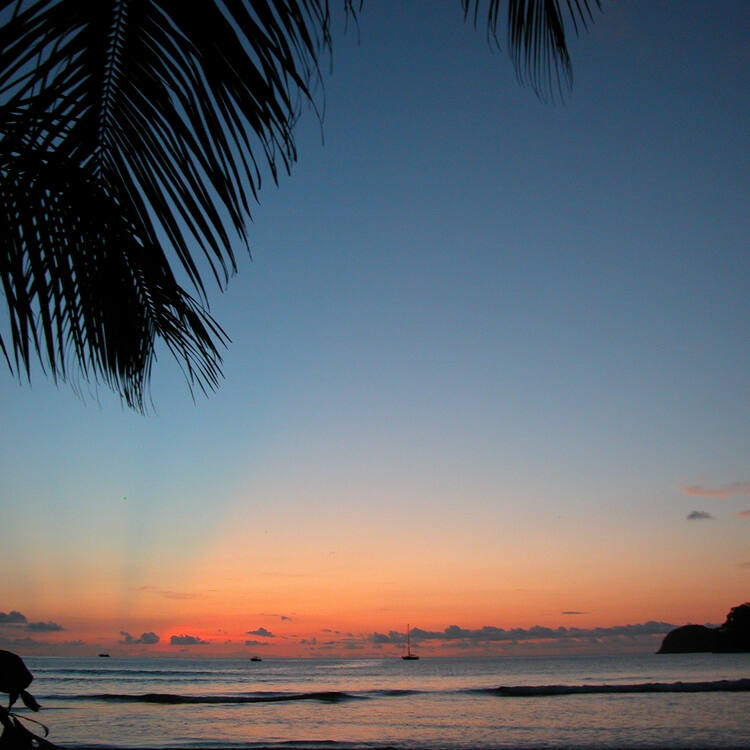
Outstanding Universal Value
Brief synthesis
Cocos Island National Park is located in the Eastern Tropical Pacific, covering an area of 202,100 hectares some 530 kilometers off the Costa Rica mainland. The island itself, “Isla del Coco”, also known as “Treasure Island”, is the only landmark of the vast submarine Cocos Range. With a surface area of 2,400 hectares it supports the only humid tropical forest on an oceanic island in the Eastern Tropical Pacific. The remaining 199,700 hectares protect not only diverse marine ecosystems, mostly pelagic but also, the most diverse coral reefs of the entire Eastern Tropical Pacific. Thanks to its remote location and conservation efforts, the biologically highly diverse property constitutes one of the best conserved marine tropical waters, well-known as a world-class diving destination. The property belongs to the Eastern Tropical Pacific Marine Corridor, a marine conservation network, which also includes World Heritage properties in Colombia, Ecuador and Panama.
Natural population densities of large top predators indicate a near pristine conservation status of a property that is among the most important sites in the Eastern Tropical Pacific for the protection of large pelagic migratory species, such as the endangered Scalloped Hammerhead Shark and the near-threatened Silky Shark and Galapagos Shark. Due to its geographical position, the oceanic island of volcanic origin is the first landmark met by the North Equatorial Countercurrent and a point of confluence of other marine currents. This makes it a dispersing centre of larvae of marine species from various parts of the Pacific Ocean. In its land portion, the property hosts a remarkable degree of endemism across most diverse taxonomic groups. There are, for instance, three endemic bird species, two endemic freshwater fish and two endemic reptile species. Cocos Island National Park is of irreplaceable global conservation value, reminding us what parts of tropical oceans historically looked like.
Criterion (ix): The property harbours a rare and complex mosaic of land and sea environments, including forested mountains, rivers, waterfalls, estuaries, cliffs, sandy and rocky beaches, bays, and extensive and highly diverse coral reefs and pelagic environments. The oceanic island, more than 500 kilometers off the continent, is mostly occupied by tropical rainforest and, from around 500 m.a.s.l. to the highest elevation at 634 m.a.s.l., by cloud forest. The isolation has been allowing ongoing evolutionary processes on land, giving origin to countless endemic species in the most diverse taxonomic groups, including several vertebrate species. The geographic location at the meeting point of the North Equatorial Countercurrent with other major marine currents and the ecological interactions between a remote island and the surrounding marine ecosystems are of major scientific importance. The currents and the island affect the movements and distribution of the many migratory marine species aggregating for feeding and reproduction in the waters around the island. The property serves as a dispersion centre of larvae of numerous marine species coming from the entire Pacific. The islets and rocks around the main island are reported to also serve as important cleaning stations, i.e. pelagic species aggregate to have parasites removed by specialised fish and other species.
Criterion (x): The small island supports the only tropical forest ecosystem located on an oceanic island within the Tropical Eastern Pacific. It is home to some 70 endemic species of vascular plants and several endemic animals, including three birds, two reptiles and even two freshwater fish. Smaller satellite rocks around the island support nesting and resting habitats for numerous migratory and resident bird species. However, the main species conservation value derives from critical marine habitat and the corresponding role of the property in the conservation of large pelagic species, especially several species of sharks. Among the latter are exceptional aggregations of the near-threatened Silky and Lemon Shark, the vulnerable Bigeye Thresher Shark and Galapagos Shark, the emblematic and endangered Hammerhead Shark, as well as White-tip Reef Shark and Black-tip Shark. Among some 300 recorded fish species are important aggregations of large pelagic fish, such as the vulnerable Whale Shark and Blue Marlin, as well as Sailfish Broadbill Swordfish, Shortbill Spearfish, Giant Manta Ray and Pelagic Stingray. Blue Whale and Bottlenose Dolphin are among the visiting marine mammals.
The isolation of Cocos Island National Park contributes to the safeguarding of evolutionary processes, which are the basis of the notable richness and abundance of land and marine life forms. Provided that alien invasive species of both flora and fauna can be controlled, the conservation prospects on land are promising. In the marine areas, the large aggregations of top predators, including but not limited to numerous shark species, demonstrate the integrity within an intensively fished marine region. The entire property is one of the rare marine no-take areas and as such makes an invaluable contribution to conservation as a safe haven for marine life, and as a nursery and dispersal centre – provided illegal fishing can be kept at bay. While many of the aggregations occur in a relatively small area within the property, the marine limits fail to do justice to the life cycles of the many migratory species. Cocos Island National Park cannot achieve the long-term conservation of species indiscriminately exploited in the wider Eastern Tropical Pacific and elsewhere. The critical factor for the long run integrity not only requires adequate management of the property but also sustainable fishing levels outside of it. The Eastern Tropical Pacific Marine Corridor provides a highly needed framework for international cooperation in this regard.
Protection and management requirements
While there is no evidence of pre-Columbian occupation, fishermen, pirates, whalers, commercial sailors and scientific expeditions have long used Cocos Island as shelter and to procure fresh water. Attempts to settle the island include a brief episode of running a prison, but eventually all such attempts have been unsuccessful. Today the human presence is restricted to a rotating group of conservation staff, tourists, and visiting scientists. The entire property is strictly protected by law, state-owned and managed by Costa Rica’s National Park Service under the Ministry of Environment and Energy in cooperation with other governmental and non-governmental institutions, such as the “Friends of Cocos Island Foundation”. Any extraction of marine resources and all commercial, industrial or agricultural activities are banned. Management planning guides interventions with a focus on planning of public use and tourism, protection of sensitive sites, alien invasive species, scientific research, and the review of relevant legislation. Sufficient staff and funding is needed to secure adequate operations, which is costly due to the remote location.
On land, the main threats are invasive alien species of both flora and fauna. While no mammals originally existed on the island, deer, wild boar, cats and rats have been introduced with complex effects on the ecosystems, as well-documented from small island settings around the globe. Temporary settlers brought plants like guinea grass and coffee. The latter has since been invading the understory of the forests. Continuous monitoring and management are needed to eradicate alien invasive species to the degree possible and to prevent new invasions through and strict and enforced protocols for all visitors to the island. In the waters, illegal fishing is common despite efforts by national authorities and non-governmental organizations. Therefore, continuous monitoring and law enforcement is needed, as is awareness-raising with the fishing industry. Tourism activities around the island, mostly recreational diving, likewise require adequate monitoring and control to prevent disturbance in the highly localised areas of major aggregations of fish, as well as littering and other pollution caused by passing vessels and yachts. Following the 1982/1983 El Niño event, about 90 percent of the coral reefs of Cocos National Park died off, a dramatic reminder how protected areas can be affected by events far beyond their boundaries. Eventually, for conservation to be effective in the long term, measures are needed at a much larger geographical scale. These measures could include extensions, buffer zones and, at the international level, coordination and cooperation with other marine protected areas in the Eastern Tropical Pacific, including World Heritage properties in Colombia, Ecuador and Panama.
- Protectedplanet.net
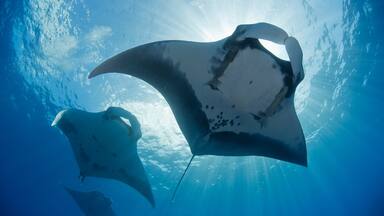
State of Conservation (SOC)
Protections by other conservation instruments.
1 protection / 1 element
- Isla del Coco
Read more about synergies
Find out why we love diving Socorro in May & June
Socorro is always stunning, raw and primal but spring is special

Cocos – Island of the Sharks
August – Mid-September
10 Days / 9 Nights 11 Days / 10 Nights
US$5,095 pp. dbl occ.
Destination Overview
Cocos Island Costa Rica – Island of the Sharks
Cocos—just the name elicits a knowing smile from experienced divers. Known as the ‘Island of the Sharks,’ it’s not just about the famous schooling hammerheads where the sharks come to you, but a tiny tropical rainforest oasis in the eastern Pacific. Here, you’ll encounter loads of white-tip reef sharks, marble rays, tiger sharks, and the ever-fascinating lobster and octopus. Of course, there are schools of juvenile horse-eyed jacks and hundreds of creole fish gathering together.
Cocos is pure magic for experienced divers, and going ashore adds an adventure of its own. Here’s an insider tip: don’t miss the suspension bridge constructed from repurposed fishing gear seized from illegal fishers. As a bonus, the 2024 expedition coincides with the peak season for humpback whales, offering a good chance of in-water sightings.
Peak Season Diving
Why summer trips? Because that’s known as the best time to visit, and August is the single most popular month.
“The rainy season” is from June through December, when the deep ocean upwellings attract manta rays, and whale sharks can sometimes be seen daily. In July and August 2021, as well as August and September 2022, humpback whales were spotted in the sheltered anchorages. Summer is also the time when the most hammerhead sharks are typically in the area. Visibility can be lower during this time, ranging from 90-ft down to 30-ft with plankton in the upper water column, but rain itself usually only lasts for 2 or 3 hours in the afternoon. Water temps around 80°F. And of course, everything shoreside is blooming with life and incredibly green during this season. Hiking the island will be offered. Special kudos to the government of Costa Rica for banning the fishing of hammerhead sharks.
Sample Itinerary
¡Bienvenidos a Costa Rican! Upon arrival at SJO (San Jose International Airport), we recommend either taking the short connecting flight on Sensa Airlines direct to Golfito. Alternatively, for more of an adventure, consider renting a car for the 6-hour drive and adventure driving down to Golfito. We highly recommend arriving in Golfito at least several days early to take advantage of pre-trip extensions. Located a few kilometres north of Golfito is the magnificent Piedras Blancas National Park, which, like so many other parks in Costa Rica, is almost bursting at the seams with an astonishing array of wildlife. Our concierge team will happily assist with hotel and resort recommendations.
Day 1: We will confirm the marina where the ship is located several months before your departure date. Boarding is at the marina at 7 pm, and the ship will sail at 8 pm. Knowing that most of our guests have to check out of their hotel or resort around noon, you are welcome to drop your gear off any time this afternoon. However, please note that our crew will be working super hard to get your ship ready for you and will not be able to accommodate early boarding. We plan to sail at 8 pm for the 30-33 hour crossing to Cocos.
Day 2: Your ship is a heavy steel stabilized oceangoing ship, ensuring you the best ride possible. We encourage you to relax, and it’s usually a good idea to take some anti-seasickness medicine just in case. It’s far better to feel 100% and enjoy the crossing than to risk feeling under the weather without medication… There will be ample time for briefings, setting up dive and camera gear, and, of course, cocktail hour at 7 pm with all our other guests!
Days 3 – 9 (11 days / 10 night trips get an extra day at Cocos!): \ Anchored in the lee of Cocos Island!! Enjoy some of the best diving in the world on the pinnacles surrounding cocos. The choice of dive sites is at the discretion of the park rangers and influenced by Mother Ocean, with a lot of input from your captain and dive guides. Typically, there will be an opportunity for 2 dives in the morning and 1 in the afternoon, with water temps ranging from 78 – 82°F (27 – 28°C). Plus, there’s the opportunity to go ashore several times, whale watch with the humpbacks, relax, and have a great time!!
Day 10: Last day at sea: We will be making our way back to Golfito, packing gear up, visiting with new friends, and planning your next adventure!
Day 11: Final day: Early arrival in port around 5 am for those who want to catch the early flight on Sensa Airlines to connect with the same departure home from SJO. For everyone else, disembarking is at 8:30 am after a leisurely breakfast onboard.
Frequently Asked Questions
Cocos island of the sharks – faqs.
What dive experience is needed? 50 logged dives and advanced open water is the bare minimum experience required to safely dive around Cocos Island. More experience is better and all divers should have good buoyancy skills. The diving can be challenging. There could be strong current on some dives. Some of the dive sites are in open water and exposed to the swell. The difference between Cocos and a destination such as Socorro is that there is no navy base or airstrip on the island which means that airplane medevac is not possible. If you have a medical issue, the boat will have to return to port or at least be met part way by fast boat. For all these reasons, these trips are best suited for good experienced divers. Don’t worry if you don’t feel that you are quite ready yet for Cocos!! Come and visit us in Baja, Sea of Cortez and Socorro and we will get you all tuned and tweaked up for this great adventure!!!
Do I need to dive with a dive guide? Yes. At Cocos, current and visibility can change dramatically within several hours. If you were to surface unexpectedly mid-dive, there is the possibility of drifting away and needing to use your Nautilus LifeLine to get rescued. In addition to those challenges, local tiger sharks can show erratic behaviour around your safety stop at 15 feet and it’s very important for our dive guides to keep a watchful eye on them. For all of these reasons, Cocos is a dive destination in which guests have to stay with our dive guides. Our dive guides are highly experienced and excellent and they will do their best to give you all the freedom and headspace you might be looking for in your diving, and of course, we are very focussed on giving shooters what they need (sorry, bad pun). Ultimately, your captain and dive guides are the final authority on whether a guest can do a specific dive or not.
What are your safety protocols? Safety, excellence in guest experience and happy staff and crew are the cornerstones of our business. Nothing is more important than your safety. At Nautilus, we are proud to be the only dive operation in the world with ISM certification and external annual audit of an SMS (Safety Management System). This is the same certification as the largest cruise ships on the oceans. We operate within written processes, procedures and checklists that our captains and crew are trained into both initially and annually. Every dive starts with a briefing on a white board. We require that all divers carry LifeLines marine rescue GPS, SMBs and dive alerts. We will loan you one of ours if you are missing any of this safety equipment. We carry AEDs and extensive medical kits with a contract medical officer available shoreside via our sophisticated satellite communication system. NOTE: because of the remoteness of Cocos Island, we highly recommend a medical checkup before leaving on this trip.
How many dives can I expect? Your dive schedule may vary according to weather, other dive boats and where the action is. You can generally expect 2 dives in the morning and 1 in the afternoon. Entry into the park is restricted and tightly controlled for diving allowing for not more than 65 divers in the park at any one time. An 11 day, 10 night trip provides for 7 dive days.
Is there nitrox onboard? Yes, and it’s highly recommended for all divers. The cost is US$ 120 per trip.
Water temperature? 78- 82 °F (27 – 28 °C).
Are the boats camera friendly? YES, VERY! Ask about rental cameras and photo pro services.
What airport do I fly into? SJO.
How do I get to the ship? TBA
What time can I board the ship? TBA
What time do we disembark? TBA
What dive gear do I need to bring? We provide aluminum 80 cu. ft tanks and weightbelts. Larger steel rental cylinders are available. 5 mm wetsuit recommended to avoid losing body core temp during multiple days of repetitive diving. It’s always better to layer down rather than be cold with no options. We have rentals onboard by prior arrangement for almost anything you need. Please make any rental requests as early as possible.
What to Expect
What’s the weather like and what clothes should I bring? Well, it’s the rainy season in the tropics!! We recommend casual and cool attire onboard (t-shirt and shorts). It can be drizzly in the afternoons and we recommend bringing a windbreaker and a fleece vest or sweater just in case. Make sure you bring good shoes if you are interested in going ashore for a hike. It’s spectacular onshore. Just wait until you see the waterfalls!
Is there internet and WhatsApp onboard? Yes. Internet and WhatsApp connection are available for $120 per trip. Please keep in mind that a satellite tracking system at sea only gives limited speed internet access. You won’t be able to stream Netflix!!
What’s the crossing like? It’s an open ocean crossing to Cocos Island Costa Rica. It can be smooth or it might be rough or more likely, something in-between. The Explorer is our flagship that has steamed through everything, from the current-swept chilly waters of Alaska to adventuring down to Clipperton Atoll, just north of the equator. We highly recommend the scopolamine “patch” and a glass of red wine to relax and have a snooze on the crossing. During the trip, we anchor in the calm anchorage behind Cocos.
Is there a fuel surcharge? Of course not! We figure that dive boat companies that with fuel, surcharges year-in, year-out are just taking an extra fee onto the trip.
What’s an appropriate crew tip? US$ 400 – $500.
Get Inspired!
Get Inspired
Watch our costa rica videos.
A-FISH-ionados Newsletter
Search nautilus website:.

What to do in Cocos Island
The Professional Association of Diving Instructors (PADI) named Cocos Island one of world’s ten best dive destinations. The rich coral reef and volcanic caves support more than 300 species of fish, including giant manta rays, sailfish, and whale sharks.

What is the Weather Like?
Cocos Island features an equatorial climate, hot and humid year-round. The (relatively) dry season extends from January to April and the wet season from June to December. However, torrential rain can be expected year-round.
The rains occur mainly in the form of downpours and thunderstorms in the afternoon. Precipitation exceeds 195 inches per year. The temperatures are high and stable throughout the year, with highs in the 80s and lows in the mid-70s. However, the heat is tempered by sea breezes.
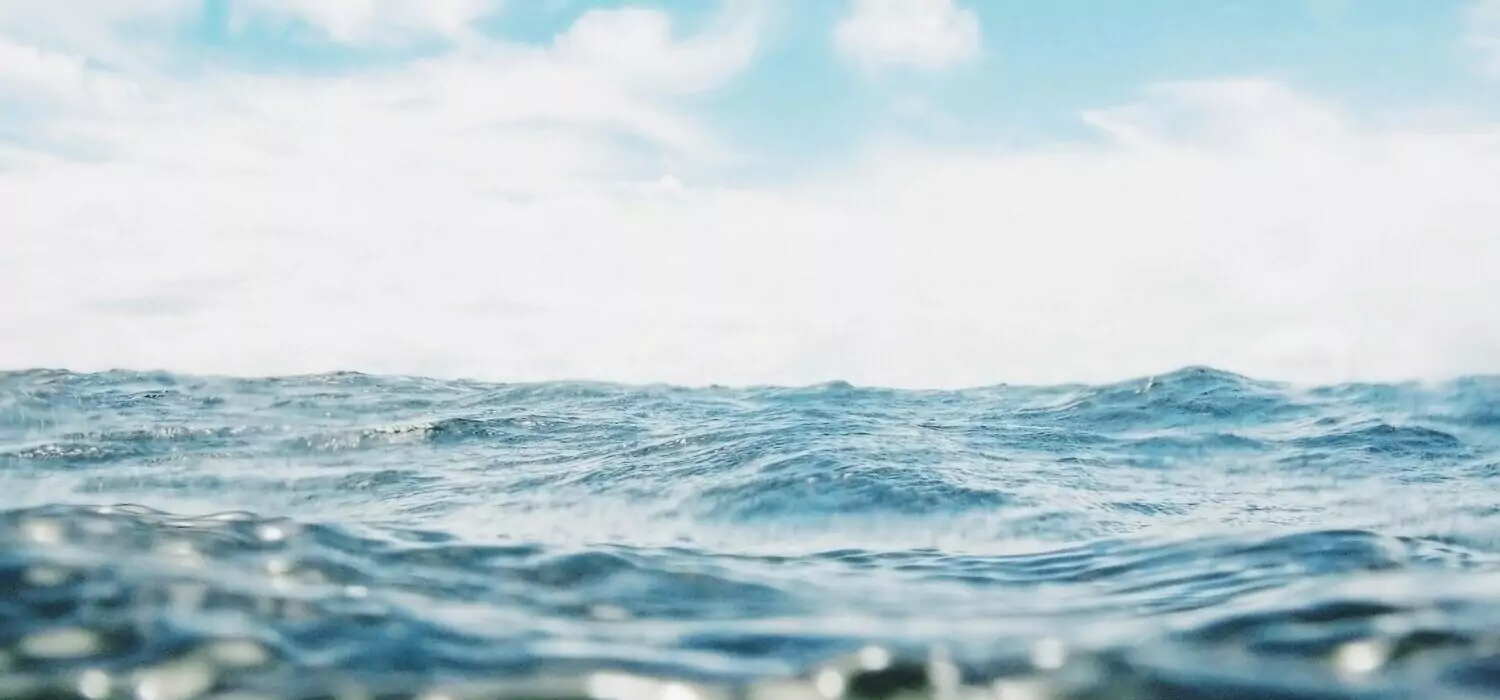
Getting There
The only way to reach Cocos is by sea. Most dive boats begin the 35-hour voyage from Puntarenas , staying at sea for ten to twelve days. Because the surrounding marine environment is so fragile, access to the island is strictly limited; fewer than 1500 people are permitted to visit each year.
Start your journey today
LANDED delivers the finest in custom, private travel to Central America, South America, and Antarctica. These regions are our passion; we know them first-hand and by heart. Speak with one of our travel designers and let us create a tailored itinerary for you in Cocos Island.
How to combine Cocos Island
Have some extra time? Here are some options for you to combine with
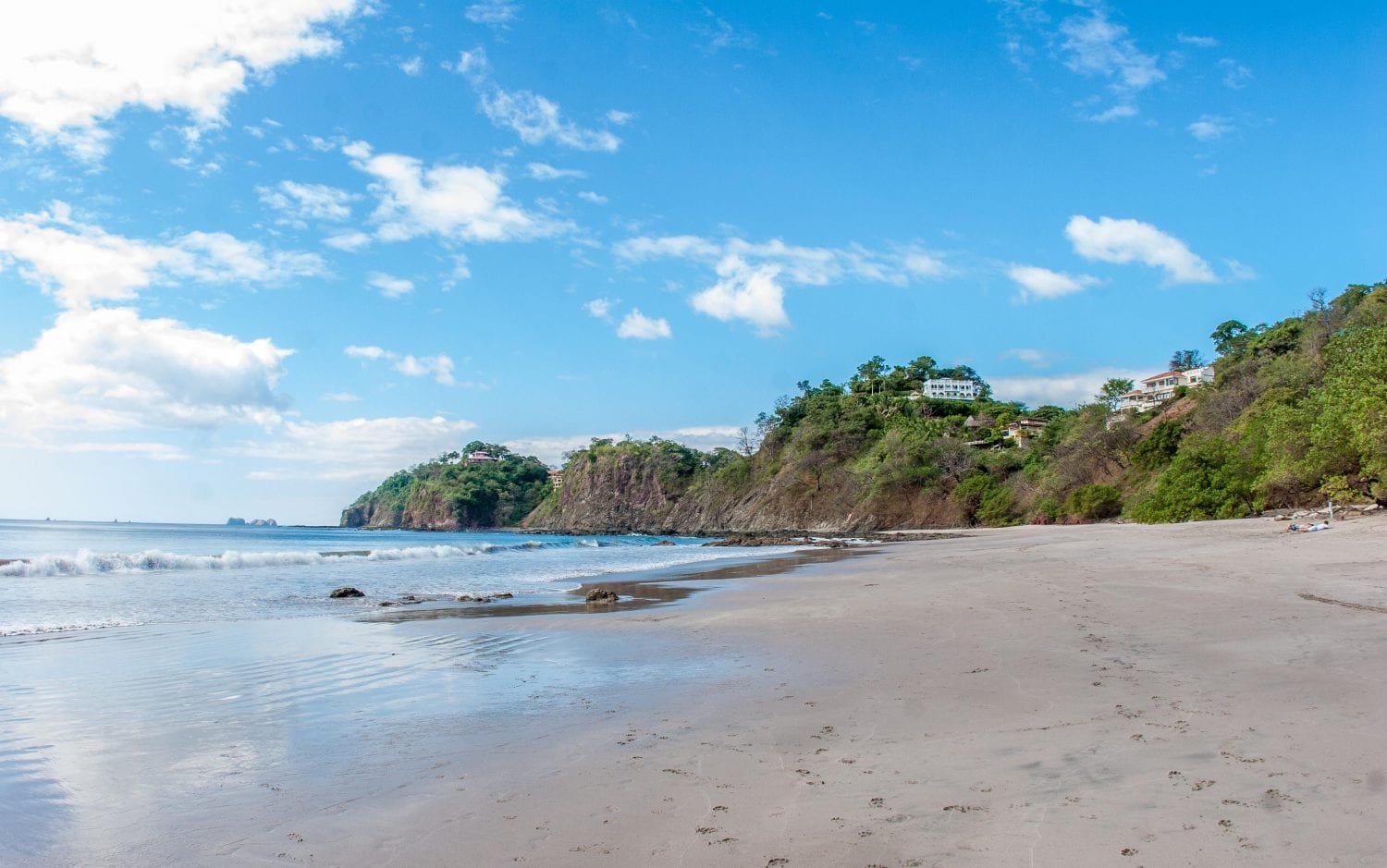
Central Nicoya
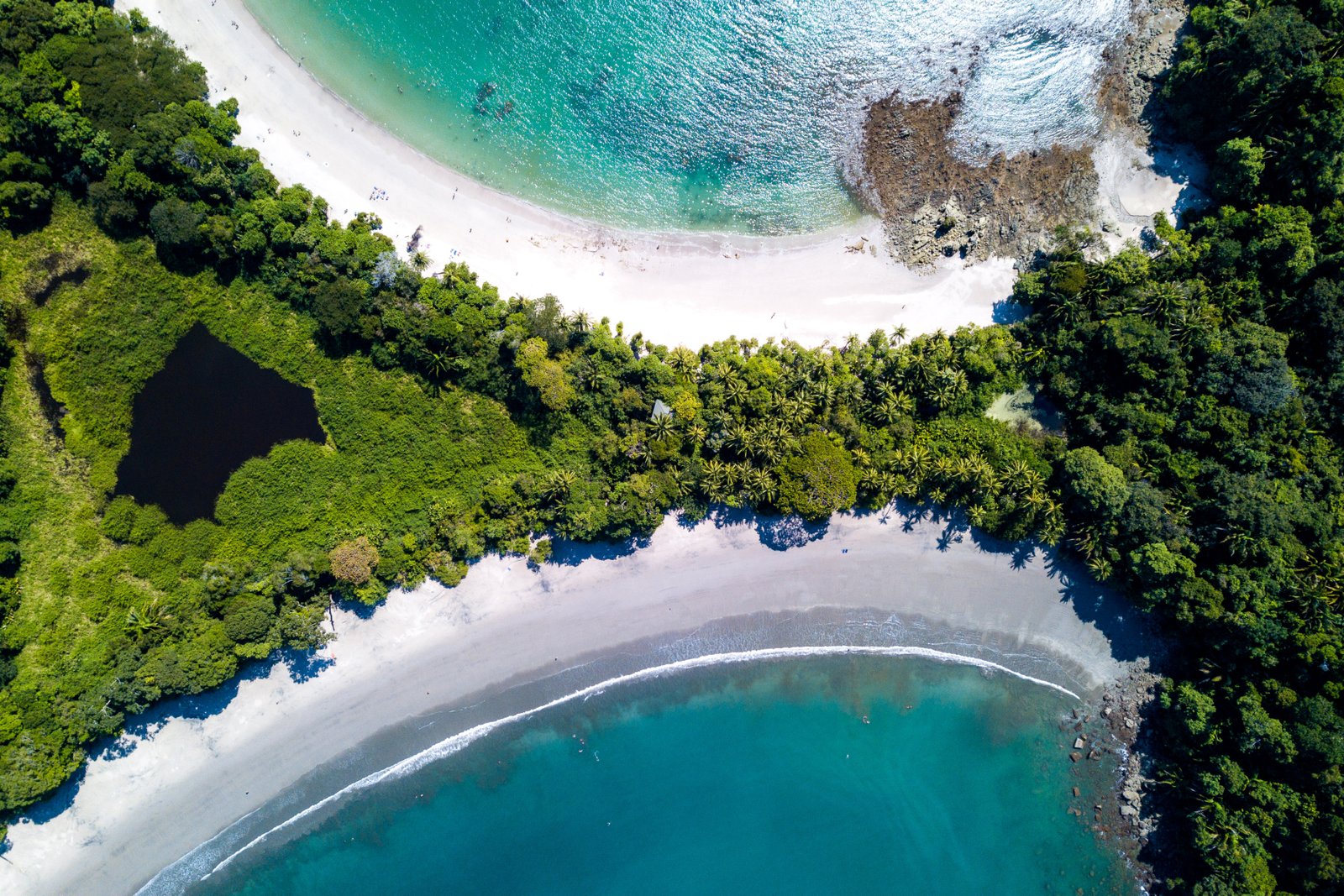
Manuel Antonio
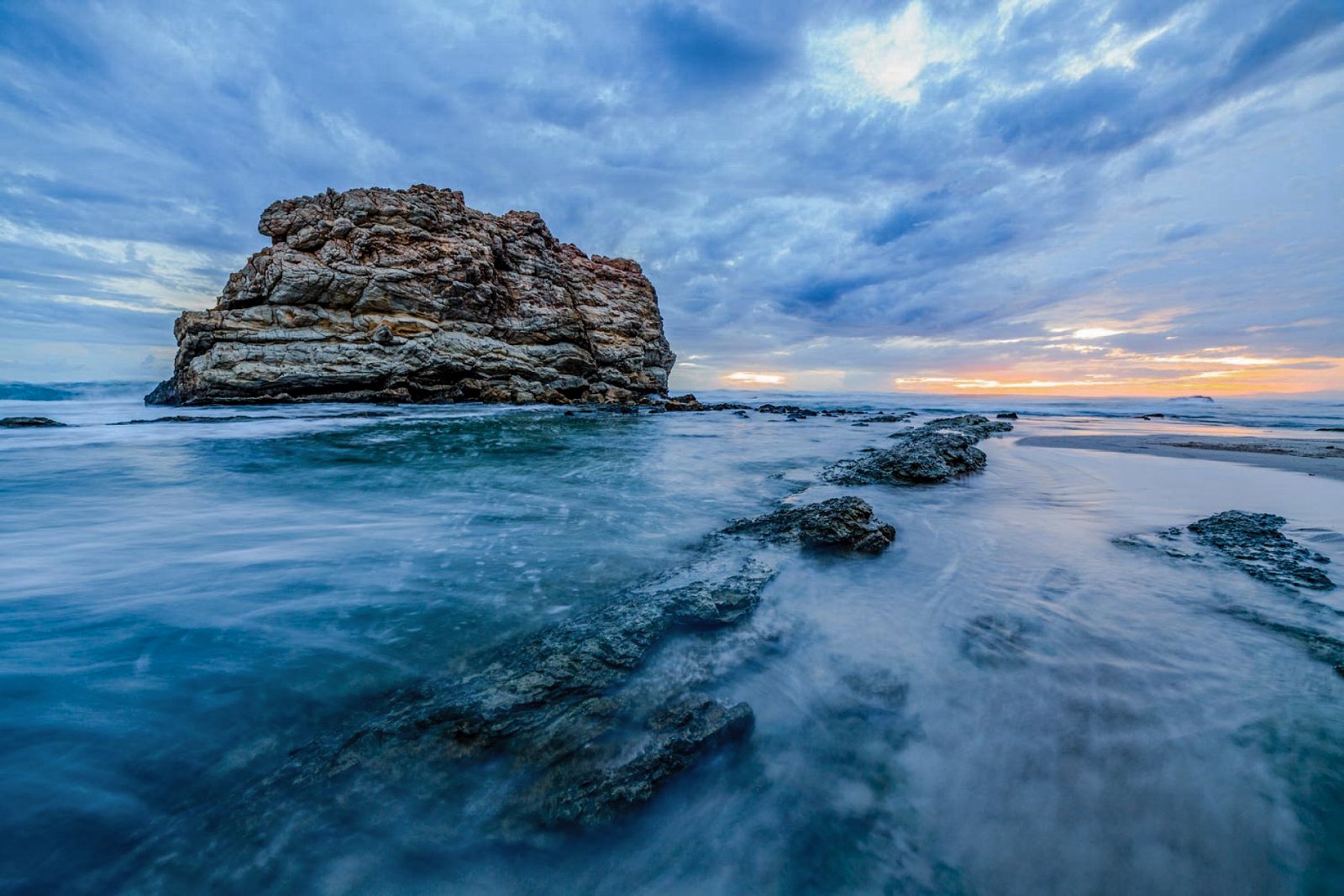
Southern Nicoya
Travel inspiration.

landed.travel
LANDED: the finest in private, tailor-made travel to Latin America and Antarctica. Smile. You’ve LANDED 🛬 www.landedtravel.com

Aggressor Adventures™
Cocos island.
- Indo Aggressor ®
Schooling hammerheads, countless white-tip sharks, mantas, tuna and even whale sharks call Cocos home.
Escape to Cocos Island for a Costa Rican liveaboard scuba diving adventure! Cocos is a lush, green uninhabited island resting 342 miles off Costa Rica's Pacific coast. Rocky pinnacles surrounding Cocos are beacons for big animals and big action. Schooling hammerheads, countless white-tip sharks, mantas, tuna and even whale sharks call Cocos home.
Specials & Unique Charters
View Dates & Details
- Explore The World Weeks - Save 25%
Travel - Cocos Island
Airfare, Hotels & Excursions
The Okeanos Aggressor II® and Cocos Island Aggressor ® depart from Puntarenas, Costa Rica. Boarding and departure depends on the tide schedule. Immediately after boarding for our Costa Rica liveaboard scuba diving adventure, the yacht departs for its 36 hour crossing to Cocos Island.
- Average dives per charter: 15 on 8 night; 21 on 10 night; 27 on 12 night No night diving is currently offered at Cocos Island.
- Depth Range: 55 ft – 110 ft (16m – 33m)
- Water temperatures range from 72 - 82F, 22 - 28C with cooler thermoclines. 3 - 5 mm wetsuit recommended
The Okeanos Aggressor II and Cocos Island Aggressor are each equipped with two 8' x 22' tenders. All dives from tenders.
Cocos Island Itinerary
Four brands, one family - choose your adventure.
- Aggressor Liveaboards™
- Aggressor River Cruises™
- Aggressor Safari Lodge™
Congratulations! You have found the hidden treasure Please fill in your name and email below so we can reach out to you
- Komodo Islands
- Raja Ampat Liveaboard
- Bunaken, Manado
- Gili Islands, Lombok
- Lembeh Strait
- Papua New Guinea
- Best Diving Centers in Jakarta
- Kapalai, Sabah
- Langkawi Island
- Layang Layang
- Mabul Island
- Mataking Island
- Perhentian Islands
- Tioman island
- Best Diving Centers in Singapore
- Koh Phi Phi
- Similan Islands
- Similan Islands Liveaboard Reviews
- Surin Islands
- Anilao, Batangas
- Bohol Island
- Boracay Island
- Coron, Palawan
- Malapascua Island
- Puerto Galera
- Maldives Liveaboard
- South Korea
- Cayman Islands
- U.S. Virgin Islands
- St. Kitts and Nevis
- Turks & Caicos
- Saint Martin
- Dominican Republic
Cocos Island Costa Rica
- Bay Islands Honduras
- British-Columbia
- Eastern Canada
- West Coast USA
- Yucatán, Mexico
- Baja California, Mexico
- Red Sea Liveaboard Reviews
- Sharm El Sheikh
- South Africa
- Great Barrier Reef
- Great Barrier Reef Liveaboard Reviews
- Ningaloo Reef
- Port Douglas
- Whitsunday Islands
- New-Zealand
- Solomon Islands
- French Polynesia
- Yap & Chuuk (Truk)
- Liveaboard Deals
- All Liveaboards
- Diving Jobs

- › Maldives
- › Indonesia
- › Thailand
- › Malaysia
- › Philippines
- › Australia
- › Red Sea
- › Liveaboards
- › Liveaboard Special Offers
- › Maldives Liveaboard
- › Raja Ampat
- › Cocos Island
- › Similan Islands
- › Komodo Islands
- › Great Barrier Reef
- › Mexico
- › Red Sea, Egypt
- › Burma
- › Palau, Micronesia
- › Fiji
- › Belize
- › Cuba
- › All Liveaboards
Cocos Island Costa Rica Travel Tips
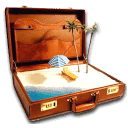
Cocos Island North Shore by Clifton Beard
Costa Rica’s Cocos Island National Park is located 340 miles (550 km) off the Pacific coast of Costa Rica. This remote location’s only tourist activity is by liveaboard boats, primarily Cocos scuba diving liveaboards . Entry to the island is by permit only and there is no accommodations on the island except for the quarters of the dozen park rangers.
Table of contents
- Cocos Island Costa Rica travel
Where to stay?
- Activies and Excursions
Health and Safety
- Where is Cocos Island Costa Rica?
- Getting there
- Getting around
- Photos Cocos Island Costa Rica
- Best dive spots
Scuba diving
I usually use this website to book in advance my hotels in Cocos Island Costa Rica as they usually have the lowest rates I find. I like it because it's free to cancel and change the dates.
Liveaboard vessels are the only option to visit the island. Some of the trips are done in cooperation with scientific research programs.
Activities and excursions in Cocos Island Costa Rica
Scuba diving is the primary focus of the liveaboards that visit the national park. Most try to provide a land excursion that includes a hike to one of the great waterfalls and swimming in the pool at the base. The hikes are guided by the park rangers and the visitors can also learn about the unique wildlife and fauna.

There are no health facility on the island so it is critical that health insurance include evacuation coverage. Dive insurance is required for all the liveaboards. Additional, some of the liveaboards require a special evacuation policy. These policies are around $30, and the dive operator can contact directly.
If you are planning an upcoming dive trip or travelling to Cocos Island Costa Rica, it is a really good idea to invest in travel insurance for scuba diving, because you never know what could happen and when you might need it (because accidents do happen!). I recommend this diving insurance as they offer worldwide coverage and focus on providing scuba divers a quality insurance and medical assistance service.
Where is Cocos Island Costa Rica located in the world?
Cocos Island (Spanish: Isla del Coco) is approximately 550 km (342 mi) from the Pacific shore of Costa Rica . The island is designated as a National Park. It is a district of Puntarenas Canton of the province of Puntarenas, where the dive boats depart from. Scuba Diving is the Cocos Islands, Costa Rica , is considered as some of the best in the World!
How to get to Cocos Island Costa Rica?

San Jose Airport By Alonso Jiménez Quesada (Own work) [CC BY-SA 3.0], via Wikimedia Commons
Do I need a visa for Cocos Island Costa Rica?
Citizens of the United States of America, Canada, Japon, Schengen Visa and/ or any country of the European Union do not need a visa to enter Costa Rica. They require just a valid passport and an outbound ticket. Citizens of other nations will need a visa, however, if they have a valid visa for any of the countries above, then they do not require a visa.

Getting Around
Transportation from San Jose to the liveaboard is generally arranged by the liveaboard company. Pick up times will vary as they depend on the liveaboard departure which is based on tide tables.
Cocos Island is a destination for the scuba diver who wants something that they can not get anywhere else in the world.
Cocos Island Costa Rica Photos
You will find all information about sea life, best time to visit, top dive spots, etc. in our review: Cocos Island Costa Rica Diving
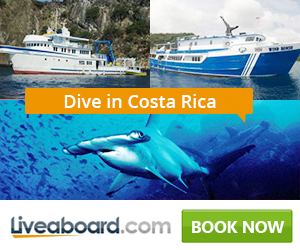
Diving Reviews for this region

Costa Rica offers experienced divers some of the best diving in the world.
Costa Rica Diving Review
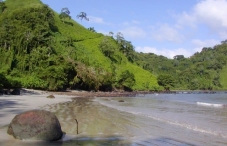
"The most beautiful island in the world." and The world's most remote diving destination with regular liveaboard service.
Cocos Island Costa Rica Diving Review
Liveaboard Reviews in Cocos & Costa Rica
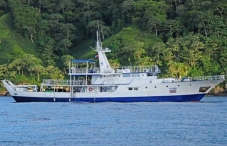
MV Okeanos Aggressor
The 33 meters liveaboard Okeanos Aggress
MV Okeanos Aggressor Liveaboard Review

The 35 meters MV Yemaya is a liveaboard
Yemaya Liveaboard Review

Cocos Island Aggressor
Journey aboard the Cocos Island Aggresso
Cocos Island Aggressor Liveaboard Review

MV Sea Hunter
Undersea Hunter fleet bought MV Sea Hunt
MV Sea Hunter Liveaboard Review
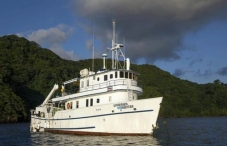
MV Undersea Hunter
Undersea Hunter Fleet are one of the pre
MV Undersea Hunter Liveaboard Review

With world-class facilities, world-class
MV Argo Liveaboard Review
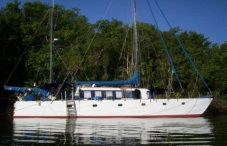
The Catamaran Inula is a unique, intimat
Inula Liveaboard Review

MV Okeanos Aggressor II
MV Okeanos Aggressor II is one of the ve
MV Okeanos Aggressor II Liveaboard Review
Cruise ship Reviews in Cocos & Costa Rica
One dive log in “cocos island costa rica”.
I would like to take a trip to Cocos Island. I am a resident of Costa Rica and A US citizen. Please send me information about a trip. I am a scuba diver also. I need to know how often you leave, I have an open schedual
Have you travelled in Cocos Island Costa Rica? Cancel reply
Have you been travelling or backpacking in Cocos Island Costa Rica? Please consider sharing your experience by leaving a comment below!
Some inspiration for your Travel Comment: How did you get there, How did you travel around, Which Hotels did you use, Did you have a good time? Your email address will not be published.
Travel Feedback
Save my name, email, and website in this browser for the next time I comment.
Diving Cocos Island Costa Rica
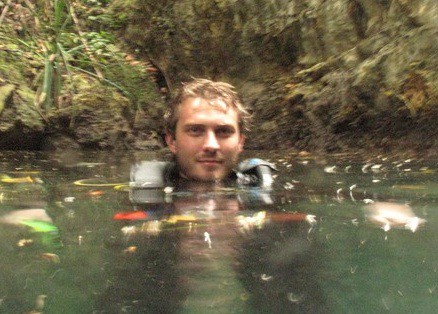
Diving in Cocos Island Costa Rica
Divezone has complete information about scuba diving and snorkelling in Cocos Island Costa Rica. For information about the best time to dive, list of fishes spotted in these waters, please check our Cocos Island Costa Rica Diving Review.


- Cocos Island Dive Expeditions
The Research
Dive operator, schedule & pricing, dive requirements, trip reviews, a 10-day liveaboard adventure to experience, view, and photograph the incredible marine biodiversity of cocos island, as well as participate in crucial shark and sea turtle migration research..
To book your adventure, select a date listed below and enter your information.
Upcoming Expeditions:
Pricing includes:.
- Ground transportation
- An 11-day/10-night cruise
- Meals and non-alcoholic drinks
- Divemaster service
- Seven full days of action-packed diving with three dives per day
- Nitrox fills, tanks and weights
Not Included:
- Transportation to Costa Rica
- Hotel in Costa Rica
- Lunch on Day 1
- Additional equipment you might need, not included in trip cost
Payment Procedure
A deposit of $700 is required in order to secure your reservation. Bookings are confirmed upon receipt of this deposit. We require payment of the remaining balance 60 days prior to your trip departure date. National park fees and all additional land tour arrangements are payable with the final balance.
Turtle Island Restoration Network is able to accept payment plans for upcoming expeditions. For more information on payment plans, please email [email protected] .

Located 530 kilometers southwest of Costa Rica’s mainland, Cocos Island National Park and World Heritage site is known worldwide as an ocean haven for spectacular sharks, rare sea turtles, whales and abundant marine wildlife. It is the only island in the tropical eastern Pacific with a tropical rainforest, and is home to large populations of scalloped hammerhead sharks, white tip reef sharks, and a number of endemic fish that occur nowhere else on the planet.
In the underwater world that surround Cocos Island, hammerheads are easily viewed at close range at “cleaning stations,” and inquisitive green sea turtles commonly approach our dive teams, offering fantastic photographic opportunities and more. Other regularly observed species include Galapagos sharks, black tip sharks, silky sharks, marbled rays, eagle rays and bottlenose dolphins. Whale sharks, the special treat of any diving expedition, are also occasionally observed. Endless schools of jacks also swarm the island.
In 1994, Jacques Cousteau described the volcanic park as “the most beautiful island in the world.” Cocos Island is said to have been the inspiration for works such as “Treasure Island” and “Jurassic Park” and it was recently named one of the best places to dive with sharks by CNN .
Led by Turtle Island Restoration Network Founder and Director Todd Steiner, biologist and respected conservation leader, expedition participants will join three fantastic dives each day, enhanced through work with Turtle Island biologists to study sea turtles and sharks, diving among schooling hammerheads, several species of sea turtles, and schools of thousands of fish as they support conservation efforts directly at the site.
Most of the action is at 60-90 feet (18-27 meters), and most dives are between 60-130 feet (18-40 meters). The average temperature is 79°F to 84°F (26°C to 29°C), although it can be a few degrees lower under the occasional thermocline.
Dive participants will have the exclusive opportunity to assist Turtle Island Restoration Network with various levels of research depending on experience and specific goals of each research expedition that may include:
- Retrieving, maintaining, and re-deploying acoustic receivers
- Censusing sharks and rays
- Providing photos for research and conservation work
- Photo-documenting species and activities
Turtle Island Restoration Network has been studying and tracking sharks and turtles at Cocos Island for almost a decade. In that time, we have seen the threats to the Park’s unique biodiversity in the form of continued illegal fishing, but also an increase in the awareness of the need to protect the marine biodiversity of this World Heritage Site. Research conducted on Cocos Island Dive Expeditions for the past 10 years has set the basis for better protections at Cocos Island and for a protected swimway to save sharks, sea turtles, and other migratory animals as they swim throughout the region.
*Current regulations of Cocos Island National Park only allow permitted scientific researchers to tag sharks, but participants will be able to observe this activity. If you scientific credentials and are experienced with the use of pole spears or spear guns, it is sometime possible to have you added to the permit. Please let us know if you are experienced and interested well in advance of the expedition.
The expedition will be supported by the experienced and well-known dive company Undersea Hunter Group , which has been operating expeditions to Cocos Island since 1990 or Aggressor Adventures . The UnderSea Hunter Group is committed to top-notch dive experiences, vessels and service, and has operated expeditions for National Geographic, Sylvia Earle, and many other world-renowned ocean explorers and conservationists. Click here to read about Undersea Hunter’s commitment to safety. Aggressor Adventures operates a fleet of dive vessels at various locales since 1984.
Participants will be divided into two dive groups which will each be under the supervision of an experienced Divemaster/Rescue Diver. Every evening, participants can enjoy engaging conservation lectures and socializing with fellow ocean lovers.
Dive participants will spend ten days aboard UnderSea Hunter’s newest vessel, the MV Argo , a beautiful 130-foot live-aboard dive vessel for up to 18 passengers and a crew of 14, where a comfortable and stylish lounge, dining area, and sun deck comprise the social areas. A well-equipped galley enables the ship’s chefs to prepare fresh, international level, four-star cuisine. Three, powerful, fumeless 24-foot skiffs serve as tender-boats.
The Argo sometimes carries a three-person submersible that may be available (at additional cost) for participants who wish to explore deep depths. To see amazing 360 degree views of Cocos Island, the Undersea Hunter vessel and underwater views from the DeepSea submersible, click here .
The following is a sample trip itinerary and is subject to change.
Arrival Day: Dive participants must arrive at least one day prior to the boat departure date. Upon arrival to San José, we can have transportation waiting for you for the cost of $10-20 or you can take a taxi to your hotel. There are always taxis available at the airport, and minivans for those of you who carry a lot of gear. We can also recommend and arrange accommodations for hotels in San José. Please note that we do not pick up from all San José hotels.
The evening before boat departure, if not before, we will confirm your pick-up time the next day. The evening is at your leisure. Air transport, airport transfers, hotel nights and meals before and after the cruise are not included in the charter.
Day 1 : The following day, generally between 8am and 1pm, we will pick dive participants up from certain hotels and transfer everybody by bus to Puntarenas where you will board the vessel. The drive takes about 2.5 hours, and gives you a chance to view the lush forest and rich farmland of the region.
Day 2 : A travel day. There will be time to arrange dive gear and camera gear as well as enjoy the Pacific and the sunshine. In addition, the group of incredibly experienced divers can provide plenty of stories to pass the time. There are videos and the experience of the Captain and crew to help you get excited for the diving…as if you need them! In addition, you may take this time to take one of our technical diving courses, at no additional cost to you.
Days 3 – 8 : The next days are spent diving the pinnacles around the perimeter of Cocos Island. Divers usually average three dives per day at depths of 60-100 feet or more. Participants will have an opportunity to help tag sharks, deploy receivers and record data during dives. Seminars and talks are provided after dinners by Turtle Island Restoration Network staff.
Day 9 : Enjoy the last three dives of the trip before cruising back to Costa Rica (and reality).
Day 10 : A travel day to discuss the diving and to compare your adventures with fellow participants.
Day 11 : Arrival at Puntarenas. Immediately after breakfast, you will be transported back to San José. We strongly recommend staying one more night on land before flying out, in case of any unforeseen delays.
The minimum required level of certification to dive at Cocos is Open Water. Divers must be experienced divers, with PADI or NAUI membership, and must have personal DAN insurance. Nitrox is available for certified divers, and certification is also available on the vessel. For more information about required certifications, please contact our trip leader Todd Steiner at [email protected] .
“ What an adventure! This is my second time to Cocos Island and this time even more amazing that the first time. Being involved with Ocean Conservation and having an opportunity to assist with the shark and turtle tagging was pure joy. I came on this trip not knowing anyone, and leaving with lifetime friends, beautiful pictures, and stories that I will be sharing back home. Janet Thomas United States
“ The experience on the DeepSee was an eye opening trip! It is a unforgettable memory through our life. Felipe our pilot is very experienced, funny and knowledgeable; thus we enjoyed the ‘ride’ with him a lot. Especially the gliding mobula rays that played with us more than 10 minutes. DeepSee Rocks! Pinky & Claus Wiesloch Germany
“ Great fun to join the PRETOMA & TIRN expedition for yet another trip. Fantastic as always. Wildlife underwater is great. Crew above water is equally wonderful. Mike and Nonie Silver United States
“ It was splendid!! I felt very happy, and very safe. Great dive masters. Everything is thought through very carefully on this boat to make guests comfortable. Extremely efficient and hard working crew. Would definitely recommend this live aboard. Bill Whitmarsh United States
“ First class operation, as always!! The crew was outstanding – very professional, helpful and fun. This was the vacation of a lifetime, and I will definitely be coming back again next year. Deborah Kearney United States
“ Another fantastic trip on the Argo – my third on the boat and fifth with the UnderSea Hunter family. The vis wasn’t as good on this trip as it’s been on past trips, but there were still sharks to be seen and turtles to be caught and tagged. The trip companions were fabulous, and the crew was outstanding as always. A big thanks to Rafa for keeping track of us while we were below the water – a welcome sight to surface to. Bryan and Yoyo were great dive masters and Javier was always smiling. I’ll be back. Mark United States
Latest News

"I recognized them, and I thought, 'Oh, man, what a bonehead mistake that I had no idea that those were in there,'" he said.
The couple were arrested and charged with possession of ammunition. Authorities seized their passports and explained the penalties they faced.
Valerie Watson said in the interview: "When I heard that, I immediately was terrified, because I was like we can't both be in prison for 12 years. We have kids at home, and this is such an innocent mistake."
The charges against her were dropped, and she returned home to Oklahoma City on Tuesday after the court hearing to be reunited with her two young children.
"Our goal is to get Ryan home, because we can’t be a family without Dad," she said.
The couple also spoke about the financial burden of a much longer-than-planned trip. "This is something that we may never recover from," Ryan Watson said.
The U.S. Embassy in the Bahamas issued a warning to travelers in September about a law that strongly prohibits possession of firearms or ammunition in Turks and Caicos, an overseas British territory southeast of the Bahamas that is a popular vacation spot.
It said: "We wish to remind all travelers that declaring a weapon in your luggage with an airline carrier does not grant permission to bring the weapon into TCI [Turks and Caicos Islands] and will result in your arrest."
The embassy added: "If you bring a firearm or ammunition into TCI, we will not be able to secure your release from custody."
The embassy and the government in Turks and Caicos did not immediately respond to requests for comment.
The same thing happened to another American, Bryan Hagerich, of Pennsylvania, who was arrested after ammunition was found in his luggage before he tried to board a flight out of Turks and Caicos in February. He said he accidentally left it in his bag.
Hagerich was on a family vacation with his wife and two young children but has now been in the country for 70 days. He spent eight days in prison before he posted bail.
"It’s incredibly scary. You know, you just don’t know what the next day may bring — you know, what path this may take," Hagerich told NBC Boston.
"You know, it’s certainly a lot different than packing your bags and going away with your family for a few days. It’s been the worst 70 days of my life," he said.
Hagerich, once a professional baseball player, was drafted by the Florida Marlins in the MLB 2007 June amateur draft from the University of Delaware.
His case goes to trial May 3.
Patrick Smith is a London-based editor and reporter for NBC News Digital.

Australia's Top Beaches Unveiled: Best Picks!
Australia boasts some of the world’s most stunning beaches. It has over 12,000 sandy stretches , perfect for beach lovers. From beaches with clear, blue waters to hidden paradises and lively spots, Australia has them all. With our guide, prepare for the best beach holiday in Australia.
Click Here to Read The Full Article
Best Beaches in Australia
Casuarina beach, the northern territory, cow bay beach, queensland, long beach, south australia, lagoon beach, lord howe island, cylinder beach, queensland, pulu blan madar island, cocos (keeling) islands, madfish bay, western australia, cockle creek, tasmania.
Casuarina Beach is in the Northern Territory and is 10th on Australia’s best beaches list. It’s over 500m long and is a beautiful spot.
It’s part of a coastal reserve, keeping it safe and pretty for everyone. This reserve guards its beauty for future generations to marvel at.
This beach is key for turtles during nesting season. Many of these amazing animals come to shore to lay their eggs. It adds a special touch to the beach experience, delighting those who visit.
Featuring sandy shores and stunning views, Casuarina is great for beachgoers . It’s perfect for relaxing on the soft sand or swimming in clear waters. The natural peace makes it a top pick for nature lovers, too.
Visitor Testimonial:
“Casuarina Beach amazed me with its natural beauty. The sight of turtles nesting was unforgettable. It’s truly top-notch in Australia.” – Emma Jones, Beach Enthusiast
Cow Bay Beach sits between the Daintree River and Cape Tribulation in Queensland . It ranked 9th among Australia’s best beaches. This spot is a hidden treasure, resembling a tropical haven with its beautiful environment and clear waters.
Picture yourself walking on soft, white sand. Feel the gentle breeze coming from the Coral Sea’s turquoise water. Cow Bay Beach is a paradise where you can get away from it all. It lets you enjoy the beauty nature has to offer.
This beach is surrounded by untouched rainforest. It gives off a calm vibe, perfect for those wanting a quiet place. You can relax under a palm tree’s shade, check out the coral reefs, or go for a laid-back stroll by the sea.
A key feature of Cow Bay Beach is its close distance to the Daintree Rainforest. This area is full of unique plants and animals. It’s a chance to see nature that is truly one-of-a-kind.
“Cow Bay Beach is the epitome of a tropical paradise. With its crystal-clear waters, lush rainforest, and picturesque coastline, it’s no wonder it made it to our list of the best beaches in Australia,” says beach expert and conservationist Brad Farmer AM.
If you love nature, adventure, or just need a peaceful beach trip, Cow Bay Beach in Queensland is a top choice. It’s a place to enjoy nature’s beauty and make unforgettable memories.
Long Beach in Robe, South Australia , is the 8th best beach in Australia. It has crystal blue water and soft sand. The blue sea and gold sand make it a beautiful place.
Looking for a quiet beach trip? Long Beach in South Australia is perfect. You can sunbathe, feel the wind, and swim. Walk by the shore, make sandcastles, or just enjoy the view.
Long Beach is more than just beautiful water. It has rocky coasts and high cliffs around it. The beach is in a natural area that stays clean and safe.
Long Beach is loved by both locals and visitors. It’s great for relaxing, having fun, or just being in the sun.
Visitor Reviews
“Long Beach is absolutely breathtaking! The water is so clear and inviting, and the sand is incredibly soft. It’s the perfect spot to unwind and enjoy the beauty of nature.” – Sarah
If you visit South Australia, don’t miss Long Beach. It’s great for beach lovers or those needing peace.
Lagoon Beach is on Lord Howe Island in the Tasman Sea and is the 7th top beach in Australia. It shows off the island’s beauty, part of New South Wales. The beach has clear blue water and soft, clean sand, making it perfect for visitors.
This beach is surrounded by green plants and big mountains, creating a peaceful atmosphere. You can relax on the sand, swim in the sea, or see amazing sea life while snorkeling. It’s an ideal spot for a memorable beach day.
“Lagoon Beach on Lord Howe Island is a hidden gem that perfectly exemplifies the beauty of Australia’s coastal landscapes. Its untouched natural surroundings and crystal-clear waters make it an ideal destination for those seeking tranquility and natural beauty.”
Lord Howe Island is a UNESCO World Heritage site with a rich marine life. You can hike, see birds, or kayak here. It’s great for both relaxing and adventurous vacations. Lagoon Beach is just one spot showing the island’s charm.
Cylinder Beach is on North Stradbroke Island , Queensland, Australia’s best beaches ranked 6th. It’s only 30 kilometers from Brisbane. This beach showcases the natural beauty and importance of sustainable resources.
This beach is a favorite because of its crystal clear waters and golden sandy shores. It’s the perfect place to escape for anyone who loves the beach and nature.
Cylinder Beach stands out for its focus on being sustainable. It’s a great example of a beach that can keep growing and being important for many years. This is thanks to the hard work of the local community and those who care about the environment.
“Cylinder Beach is a stunning place that needs our care. Its spot on Australia’s top beaches shows how important it is and the work done to keep it safe.”
At Cylinder Beach, you can do lots of fun things. Like swimming, snorkeling, having a picnic, or looking for treasures on the sand. The waves are great for surfing, bringing surfers from all over.
There are also many useful things at the beach. Such as areas for picnics, spots for barbecues, and restrooms. These things make sure you have a great time at Cylinder Beach.
Cylinder Beach Facilities
Cylinder Beach is special due to its beauty, care for the environment, and facilities. It’s one of Australia’s best beaches. If you’re in the area, don’t miss the chance to visit and see the true beauty of Queensland’s coast.
Pulu Blan Madar Island is in the Cocos (Keeling) Islands , a remote spot making the top 5 beaches in Australia. Tucked away in the Indian Ocean, it’s a quiet escape for those who love the beach.
It’s about 2750 kilometers from Perth, making it quite far away. This island is one of 27 in the Cocos (Keeling) group, all beautiful.
What makes this island special is its natural beauty, untouched by many visitors. White sand, tall palm trees, and stunning blue sea welcome you.
Here, you can relax under palm trees or dive into clear waters. Everything is peaceful, with the sound of waves and soft sand.
Don’t miss the chance to see the hidden spots, great for snorkeling. The clear waters hide colorful reefs and fish, perfect for underwater adventures.
Its remote nature is what makes it charming. Few people come here, so you can really connect with the pure surroundings.
For your trip, pack everything you need as there are only basic services. Don’t forget sunscreen, bug spray, and water for a safe and enjoyable time.
Visit Pulu Blan Madar Island to enjoy its beauty. Feel the calm on its beaches and explore its wonders. This is a place that amazes anyone who loves the sea.
Madfish Bay in Denmark , Western Australia , is the 4th best beach in Australia. It’s famous for its beautiful rocks and green settings, making the coast look like a painting.
Exploring Madfish Bay
Located in Denmark , this beach has a lot to offer. It has tiny islands and rocks in its clear blue waters. This makes the area great for adventures and photos.
The rocks and islands are also homes to many sea creatures. If you like snorkeling or diving, you’ll see bright fish and lovely corals. Sometimes, lucky visitors spot sea turtles or playful dolphins.
On the shore, there’s pure peace. You can lay on the soft sand, surrounded by green plants. The beach looks like a perfect calm scene in nature.
But, keep an eye out for snakes and watch your step. Stick to the paths to stay safe and not harm the animals that live there.
Facilities and Amenities
Madfish Bay offers facilities like picnic spots and bathrooms. There’s also parking close by. This makes visiting comfortable for everyone.
Families can picnic and enjoy the view. It’s set up for a day of fun under the sun.
Madfish Bay is a dream spot for beach lovers. With its unique rocks and green views, it’s truly special. It rightly earns a top spot among Australia’s finest beaches.
Cockle Creek in Tasmania is the third-best beach in Australia. It’s earned its spot on a prestigious list. When you first step onto Cockle Creek’s sandy shores, you’ll know why.
It’s right on the edge of the famous Tasmanian Wilderness World Heritage Area. This means it offers a one-of-a-kind experience. The beach is truly a hidden gem enclosed by natural beauty.
As you explore, the peace and quiet of Cockle Creek will enchant you. Its clear waters meet untouched wilds, creating a stunning view. Here, you can either relax under the sun or find adventure along the coast.
Top Safari Location in Australia for Wildlife
Best Diving Spots in Australia
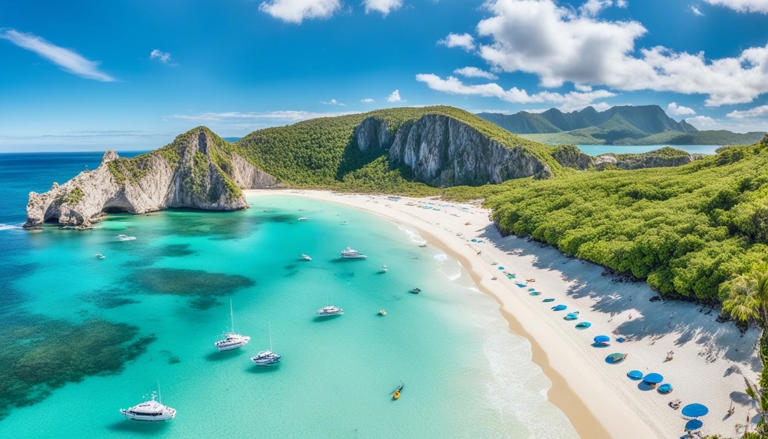

IMAGES
VIDEO
COMMENTS
A visit to to the ranger station and a hike up to a viewpoint is also a must do on Cocos Island. A dive trip to Cocos is an adventure of a lifetime and well worth the 36 hour crossing from Puntarenas on mainland Costa Rica. Visited on 10/2016 - Submitted on 11/06/2017 Images. Liz. Simi Valley, CA United States.
Aggressor Fleet Dive Trip to Cocos Island. Feb 2012 • Couples. We flew into San Jose, Costa Rica, spent the night and was picked up the next day for travel to the Pacific Coast to board the Okeanos liveaboard dive boat of the Aggressor Fleet. We traveled 320 miles which took approximately 32 hours to reach Cocos Island, a national park and ...
For more Cocos (Keeling) Islands travel tips, visit the website. The Cocos (Keeling) Islands experience a consistent tropical climate year-round. Temperatures rarely drop below 24°C (75°F) even at night, so packing lightweight clothing is a good idea. Rainfall is typically higher between March and July, but this season also brings higher ...
From San José, take the route towards Caldera to Puntarenas. From the Port of Puntarenas you can reach Isla del Coco National Park by boat. The trip takes about 36 hours. The park is open all year, every day of the week. There are two sectors: Bahía Wafer and Bahía Chatham. Universal Path.
The Okeanos Aggressor, MV Argo, and Undersea Hunter travel a week and a half to the island; hence, it is advisable to plan and book your seats in advance. About Coco's Island National Park Coco's Island National Park was established in 1978 to home 270 types of fish, around 235 varieties of plants, over 400 types of insects, and 30 kinds of ...
Cocos Island National Park: Nestled in the vast expanse of the Pacific Ocean, some 330 miles (523 km) off the coast of Costa Rica, Cocos Island National Park, also known as Isla de Coco, emerges as an unrivaled gem. ... Let us make you a free custom trip plan! Call us toll-free today 1-866-853-9426. Check out what other travelers are saying ...
Visiting Cocos Island. Coco Island was declared a National Park and conservation area in 1978 and became a UNESCO World Heritage Site in 1997. It is located about 550 km from the Pacific Coast and takes roughly 36 hours to reach. The fantastical atmosphere made Isla del Coco the island double for Isla Nublar in the Jurassic Park movies. For the tourists, it can prove a worthy competitor for ...
Cocos Island, Costa Rica is a remote island destination on the Pacific Ocean. This is a protected area and part of the Costa Rica national park system. The island is located 300 miles off of mainland Costa Rica and the only way to visit is with a multi-day liveaboard scuba diving tour. The real draw to this remote destination is the abundance ...
Average Temperature: 76º-85º F (24º-29º C) Costa Rica, a country known for its popularity, holds a hidden treasure that remains undiscovered by many: Cocos Island (Isla del Coco). Tucked away in the vast Pacific Ocean, approximately 340 miles off the coast, this island is a true gem. Despite being a part of Costa Rica's national parks, it ...
Cocos Island is an amazing, lush green and uninhabited island located 600 km (375 miles) off Costa Rica's Pacific coast. Its beautiful turquoise water. ... The trip takes about 36 hours. The park is open all year, every day of the week. There are two sectors: Bahía Wafer and Bahía Chatham. Snorkeling is a favorite pastime. For visitors, there ...
October 19, 2011. • 2 min read. Three hundred miles—and a 36-hour boat ride—southwest of mainland Costa Rica, a lush volcanic island rears up improbably out of the Pacific Ocean. Cocos is at ...
Understand. Cocos Island is in the Eastern Tropical Pacific approximately 300 mi (480 km) southwest of Cabo Blanco, Costa Rica. A rugged and incredibly beautiful island, today Cocos Island is the most sacred National park in Costa Rica's extensive park system. Among Cocos Island's many attributes is a startling degree of biodiversity.
The sail from Costa Rica to Cocos is around 36 hours long which means that most diving liveaboard itineraries are around 8-10 days. The Okeanos Aggressor I and II offer the best facilities including a plasma TV with DVD entertainment for the long crossing to Cocos. The Sea Hunter, Undersea Hunter and Argo are all refitted commercial diving ...
Cocos Island, in the deep Pacific, some 550km off the Costa Rican coast, is one of the top dive destinations in the Americas and together with the Galapagos one of the best destinations for marine wildlife in the Eastern Pacific. ... The only way to reach the islands is on an 11-day liveaboard dive trip. Two boats run by Under Sea Hunter leave ...
When you travel to Cocos island, you will fly into San Jose, Costa Rica, where you will stay for one or more nights before transferring to Puntarenas, from where the liveaboard to Cocos island will depart. Upon entering Costa Rica, you will receive a visitor visa up to 90 days from arrival. Be sure to have your valid passport with at least one ...
Brief synthesis. Cocos Island National Park is located in the Eastern Tropical Pacific, covering an area of 202,100 hectares some 530 kilometers off the Costa Rica mainland. The island itself, "Isla del Coco", also known as "Treasure Island", is the only landmark of the vast submarine Cocos Range. With a surface area of 2,400 hectares ...
Days 3 - 9 (11 days / 10 night trips get an extra day at Cocos!): \ Anchored in the lee of Cocos Island!! Enjoy some of the best diving in the world on the pinnacles surrounding cocos. The choice of dive sites is at the discretion of the park rangers and influenced by Mother Ocean, with a lot of input from your captain and dive guides.
Most dives take place from 60 to 130 feet (18 to 40 m). Water temperatures average from 79 F to 84 F (26 to 29 C), so you'll want either a 3 mm or 5 mm full wetsuit. Hoods keep you warmer for repetitive diving, and gloves are a must. Visibility changes throughout the year, but averages 60 to 100 feet (18 to 30 m).
Welcome to Cocos Islands Adventure Tours. Explore the pristine clear waters of the Southern Atoll in a Motorised Outrigger Canoe. Make new friends, learn some of the interesting history of the Islands, take in the spectacular scenery, look out for the numerous birds, turtles and crabs.
Cocos Island National Park rises from the Pacific 300 miles from Costa Rica's mainland. This isolation has aided the island's preservation. In recognition of its unique forest and marine ecosystems, Cocos was designated a World Heritage Site by UNESCO in 1997. The island's heavy rains—more than 275 inches annually—support tropical ...
The Okeanos Aggressor II® and Cocos Island Aggressor ® depart from Puntarenas, Costa Rica. Boarding and departure depends on the tide schedule. Immediately after boarding for our Costa Rica liveaboard scuba diving adventure, the yacht departs for its 36 hour crossing to Cocos Island. Average dives per charter: 15 on 8 night; 21 on 10 night ...
Costa Rica's Cocos Island National Park is located 340 miles (550 km) off the Pacific coast of Costa Rica. This remote location's only tourist activity is by liveaboard boats, primarily Cocos scuba diving liveaboards.Entry to the island is by permit only and there is no accommodations on the island except for the quarters of the dozen park rangers.
Fall 2024. August 27 - September 2024. Price: $6,600 USD + $550 USD National Park Fee. Space Available on Upcoming Cocos Trip!!! This is a highlight trip of a lifetime! Join Turtle Island's Todd Steiner, and Randall Arauz on a shark tagging expedition to Cocos Island, Costa Rica, one of the most incredible underwater dive sites on the planet!
April 24, 2024, 4:51 AM PDT. By Patrick Smith. An Oklahoma man faces up to 12 years in prison on a Caribbean island after customs officials found ammunition in his luggage. Ryan Watson traveled to ...
Pulu Blan Madar Island is in the Cocos (Keeling) Islands, a remote spot making the top 5 beaches in Australia. Tucked away in the Indian Ocean, it's a quiet escape for those who love the beach.